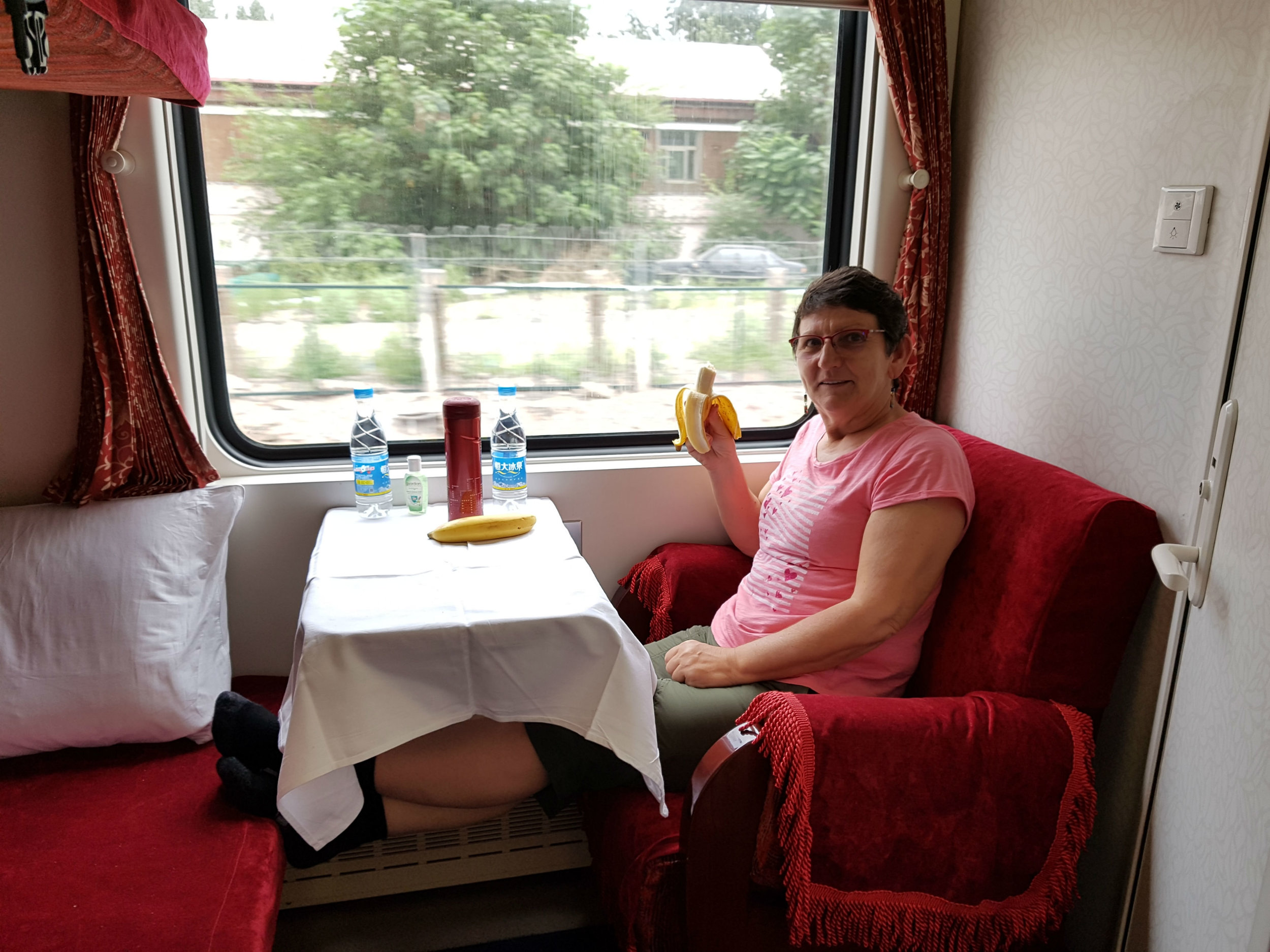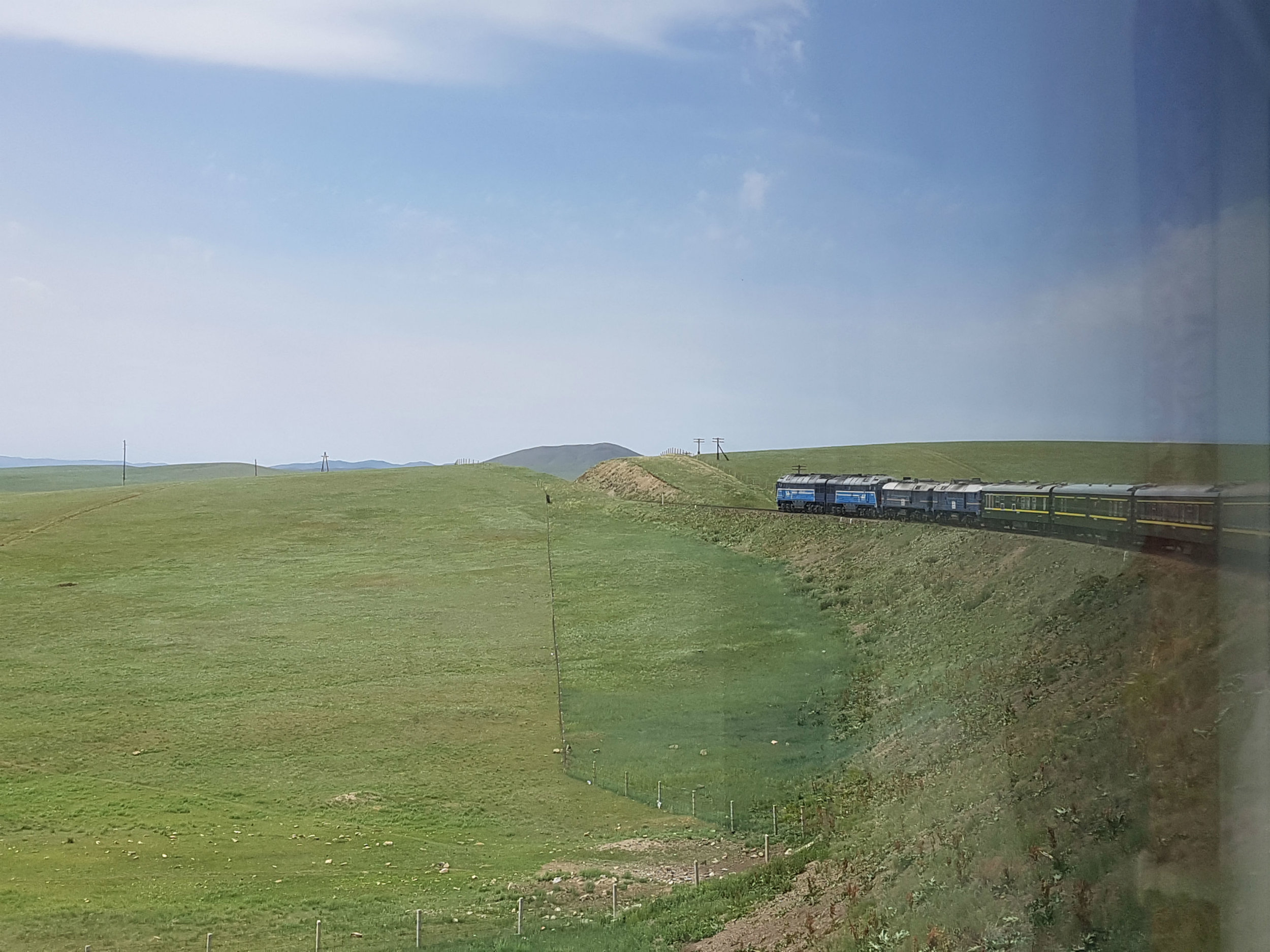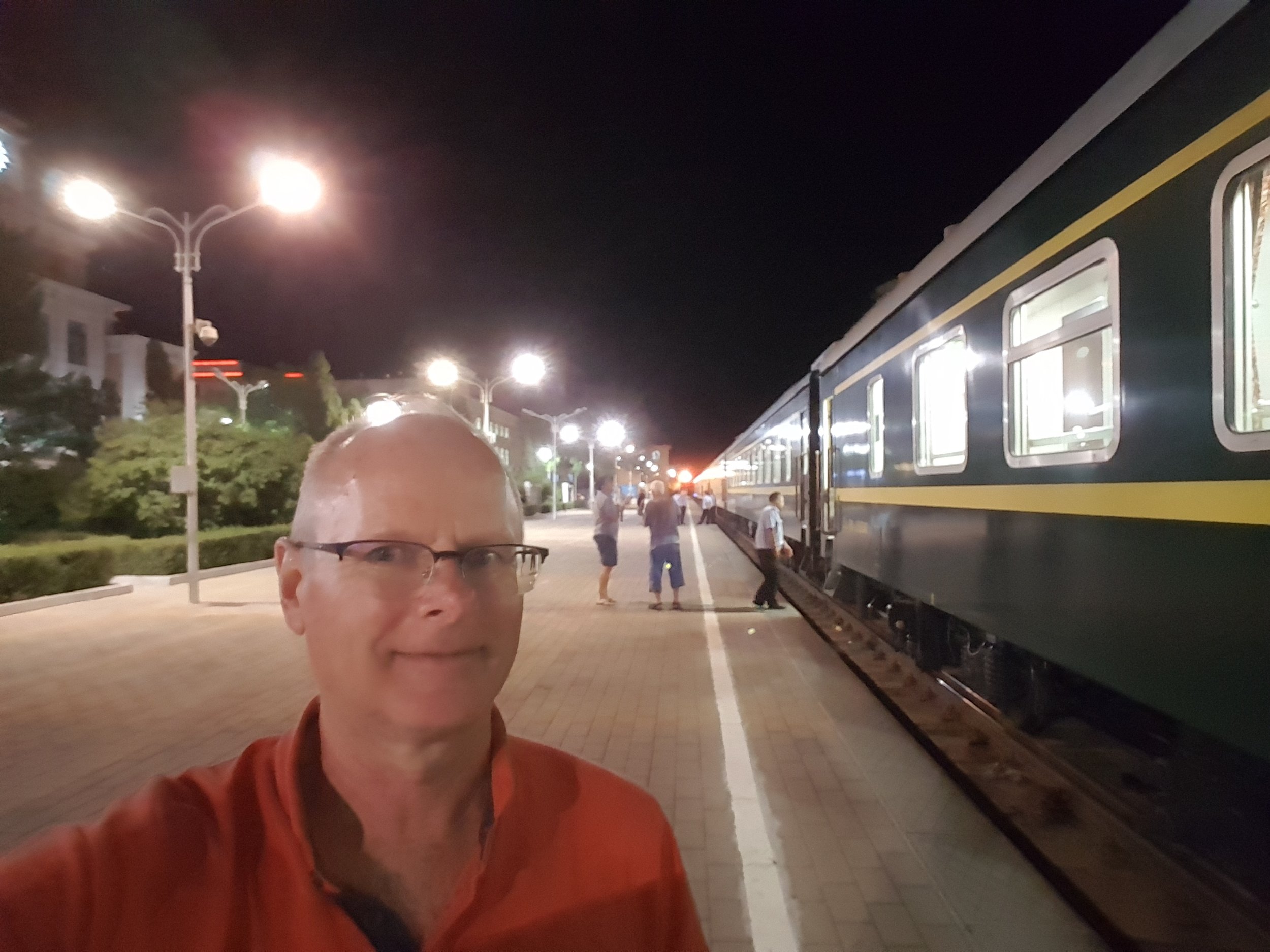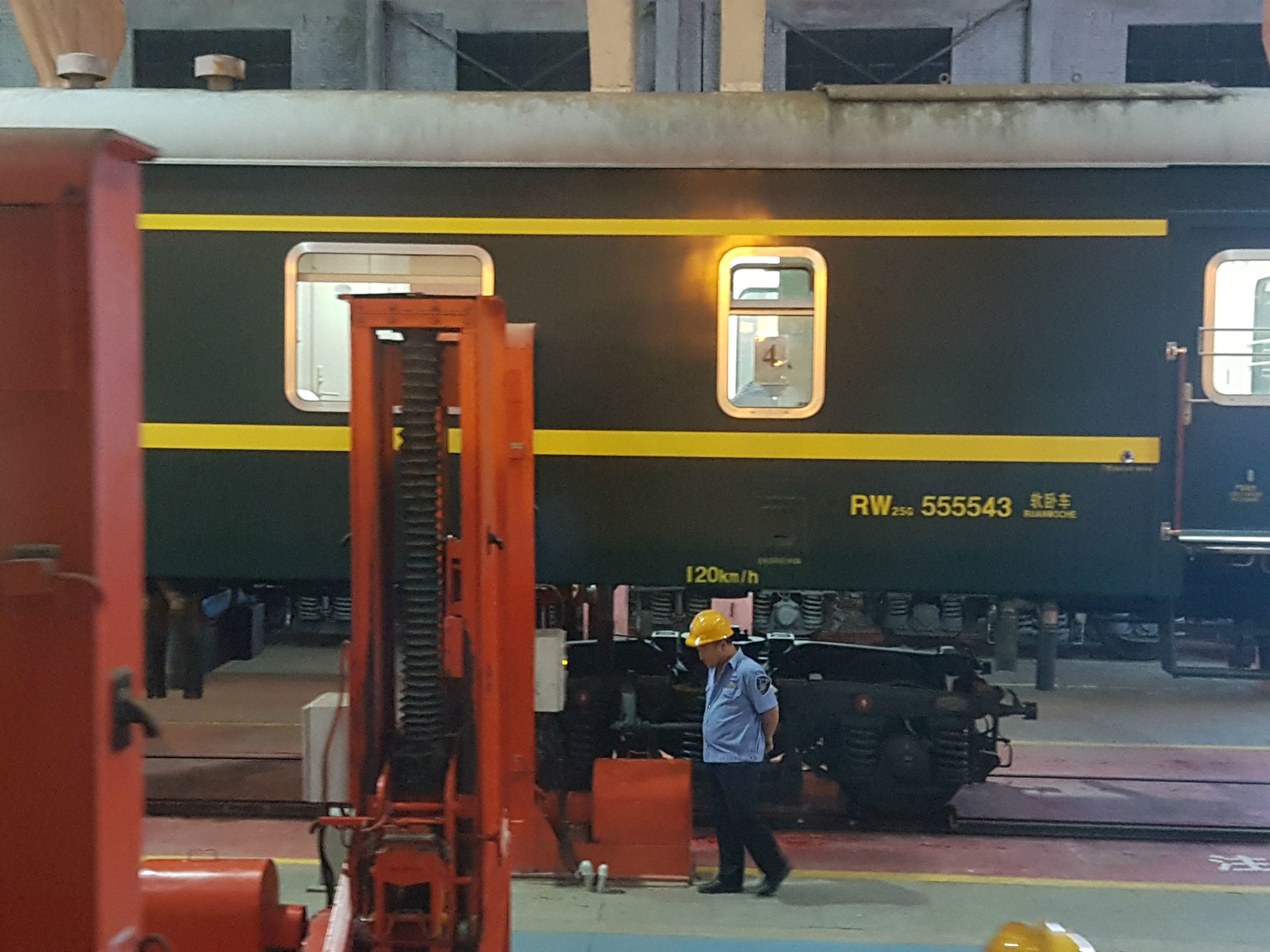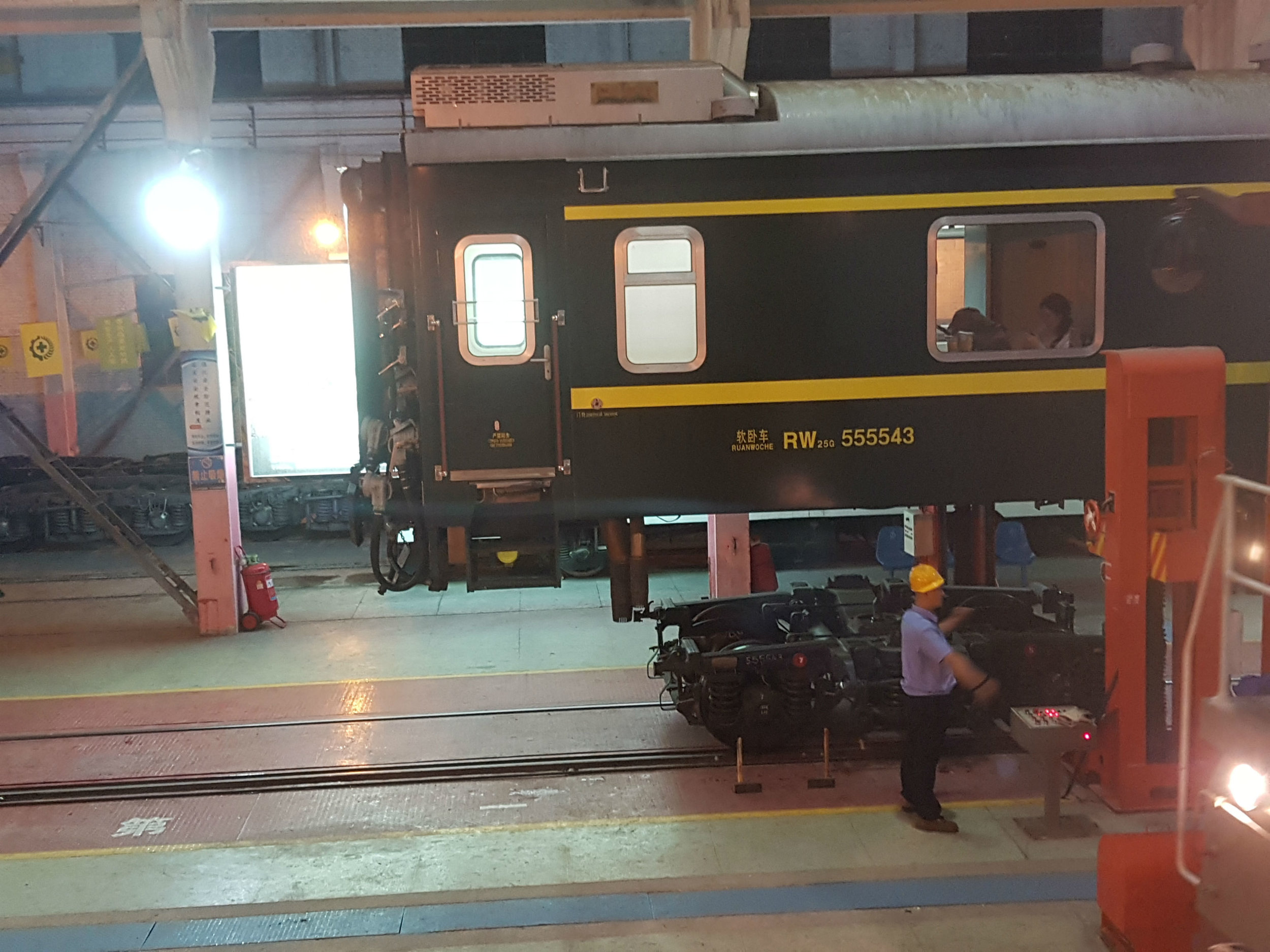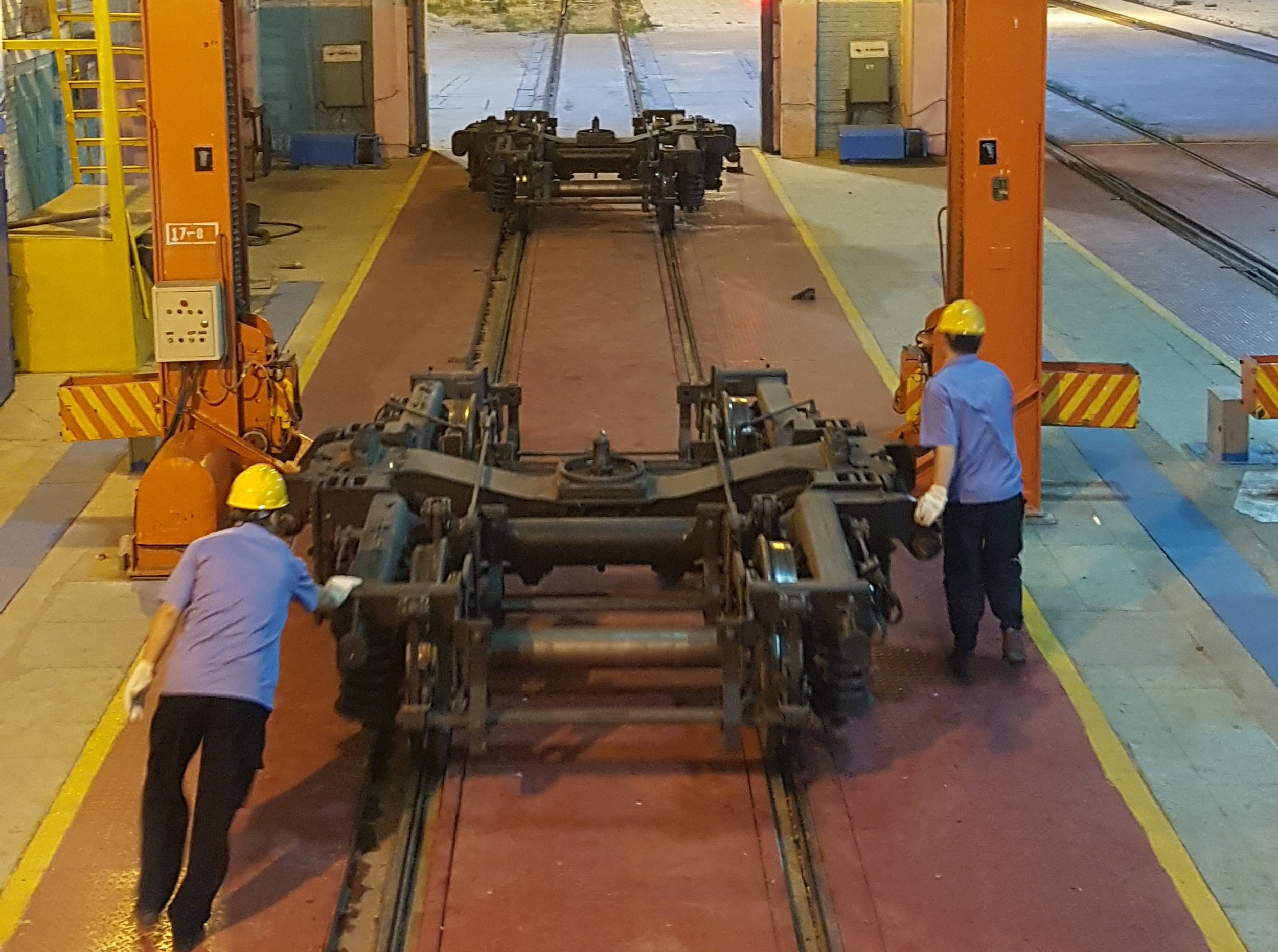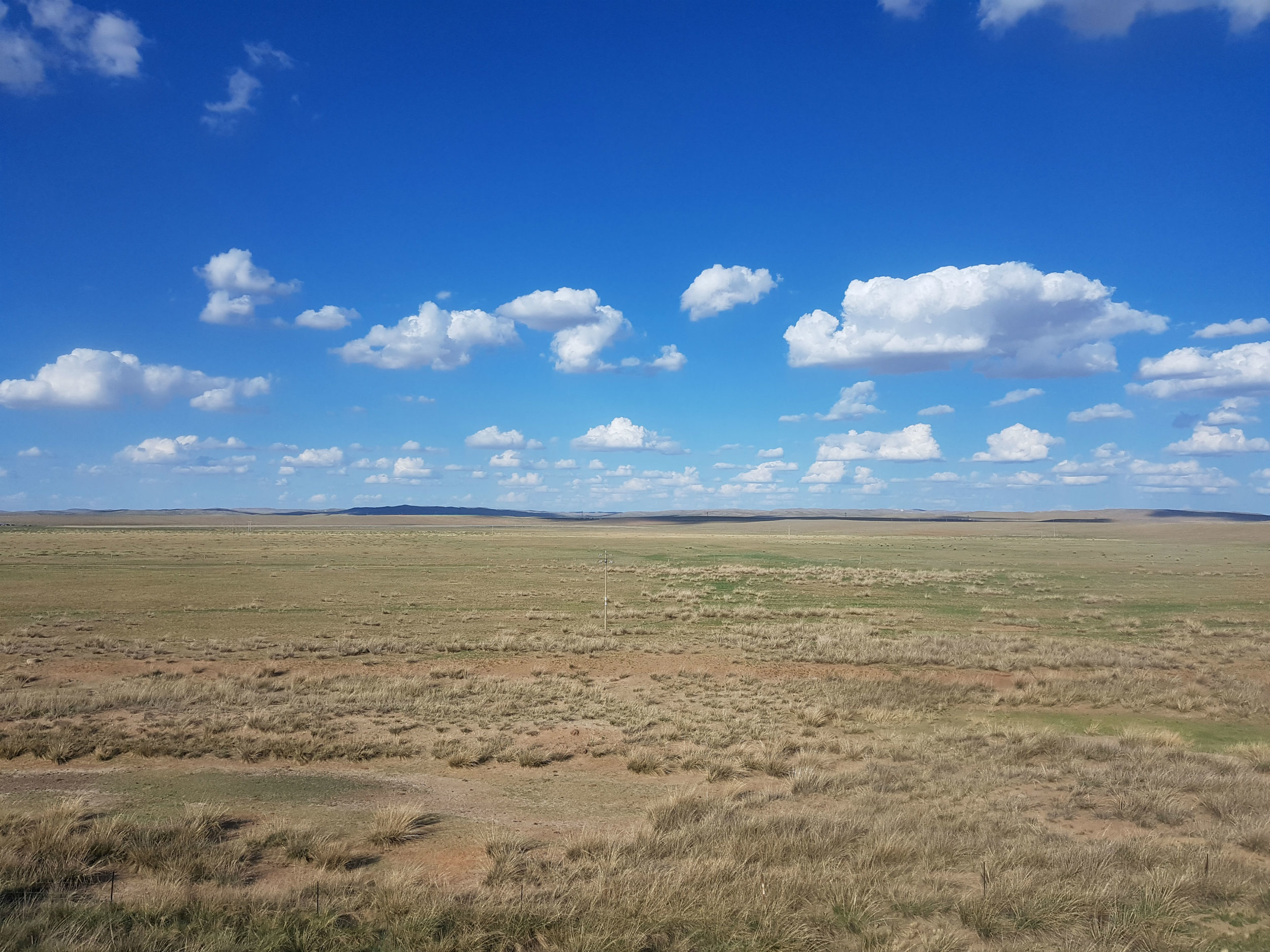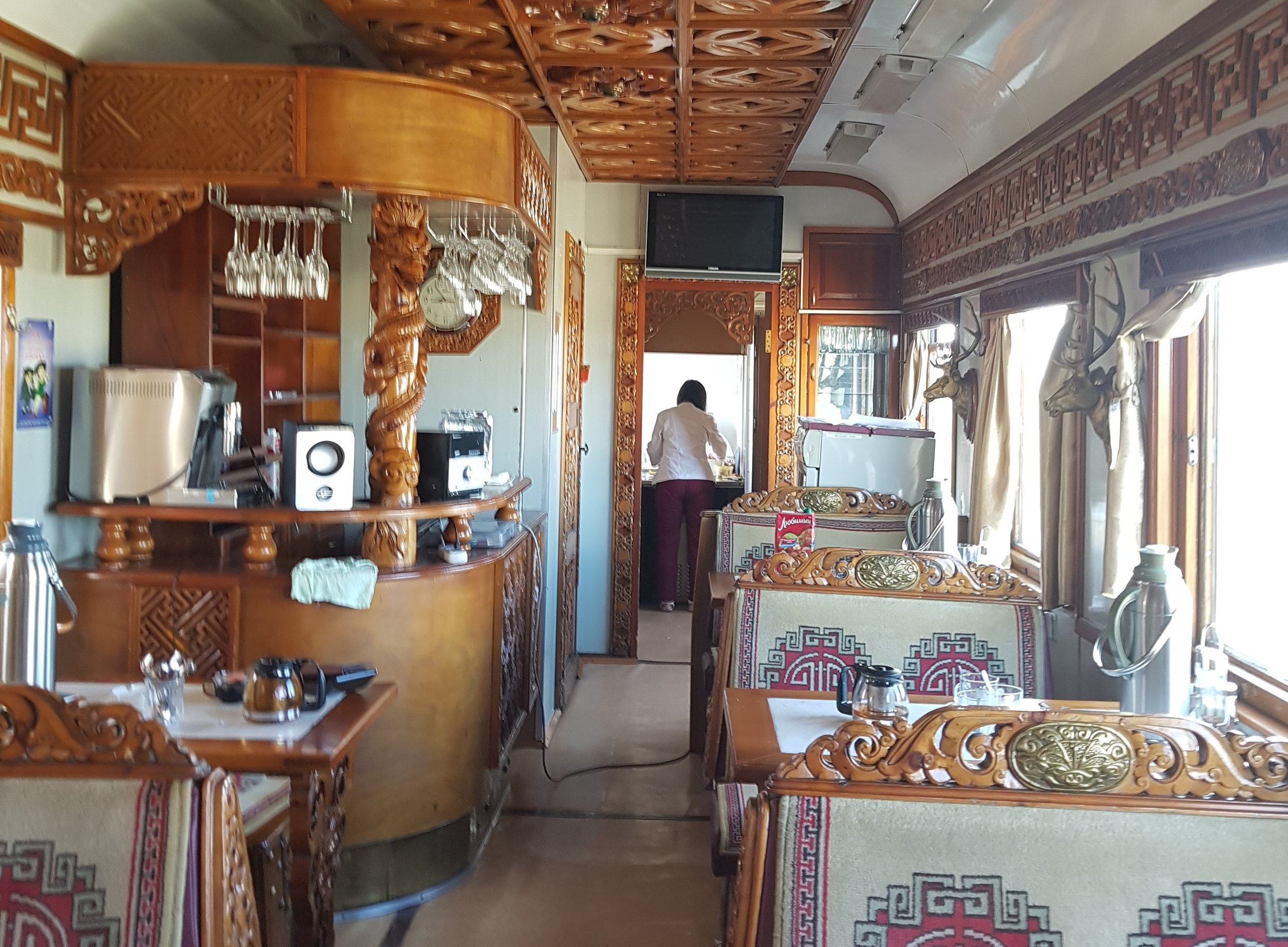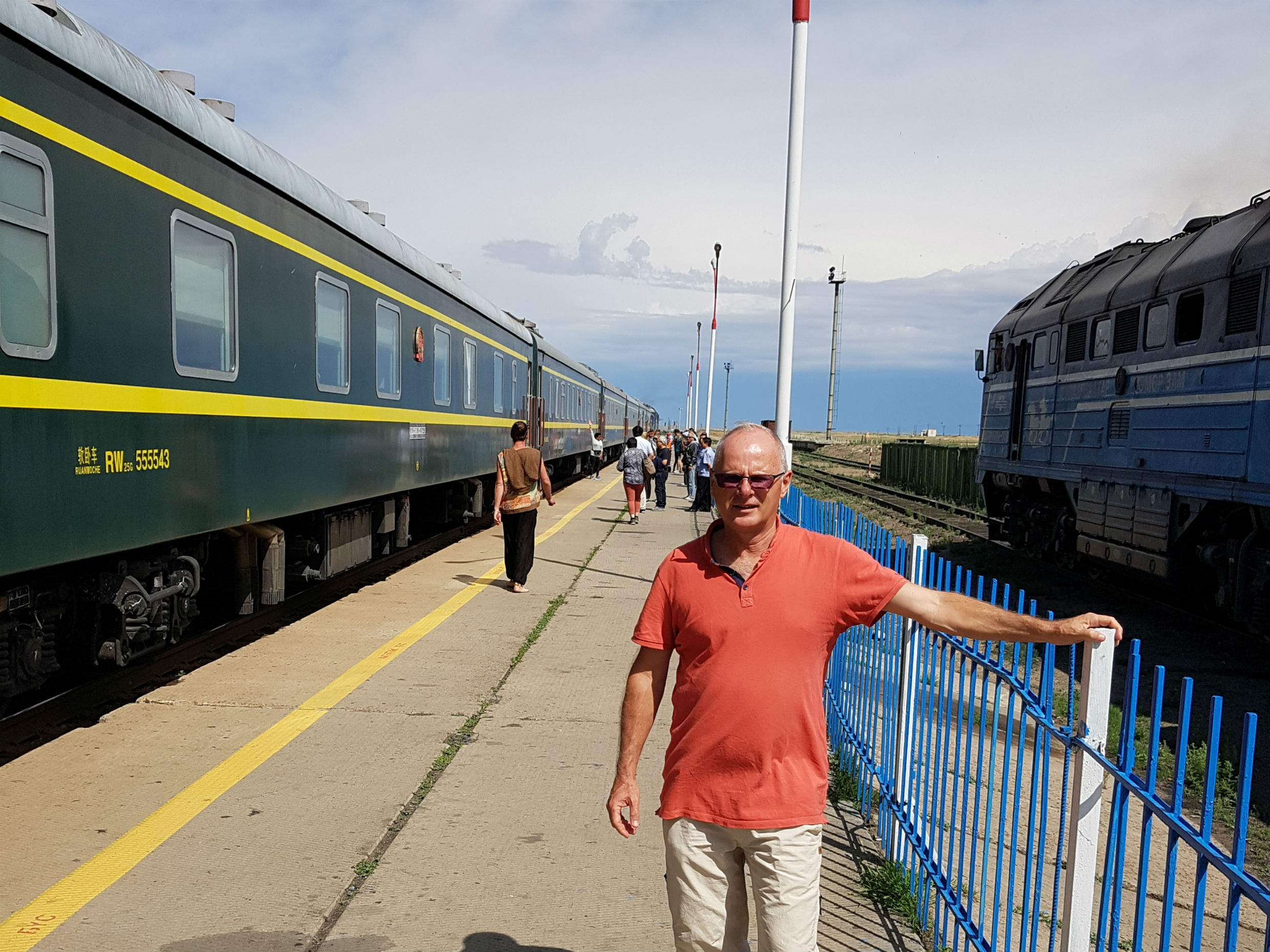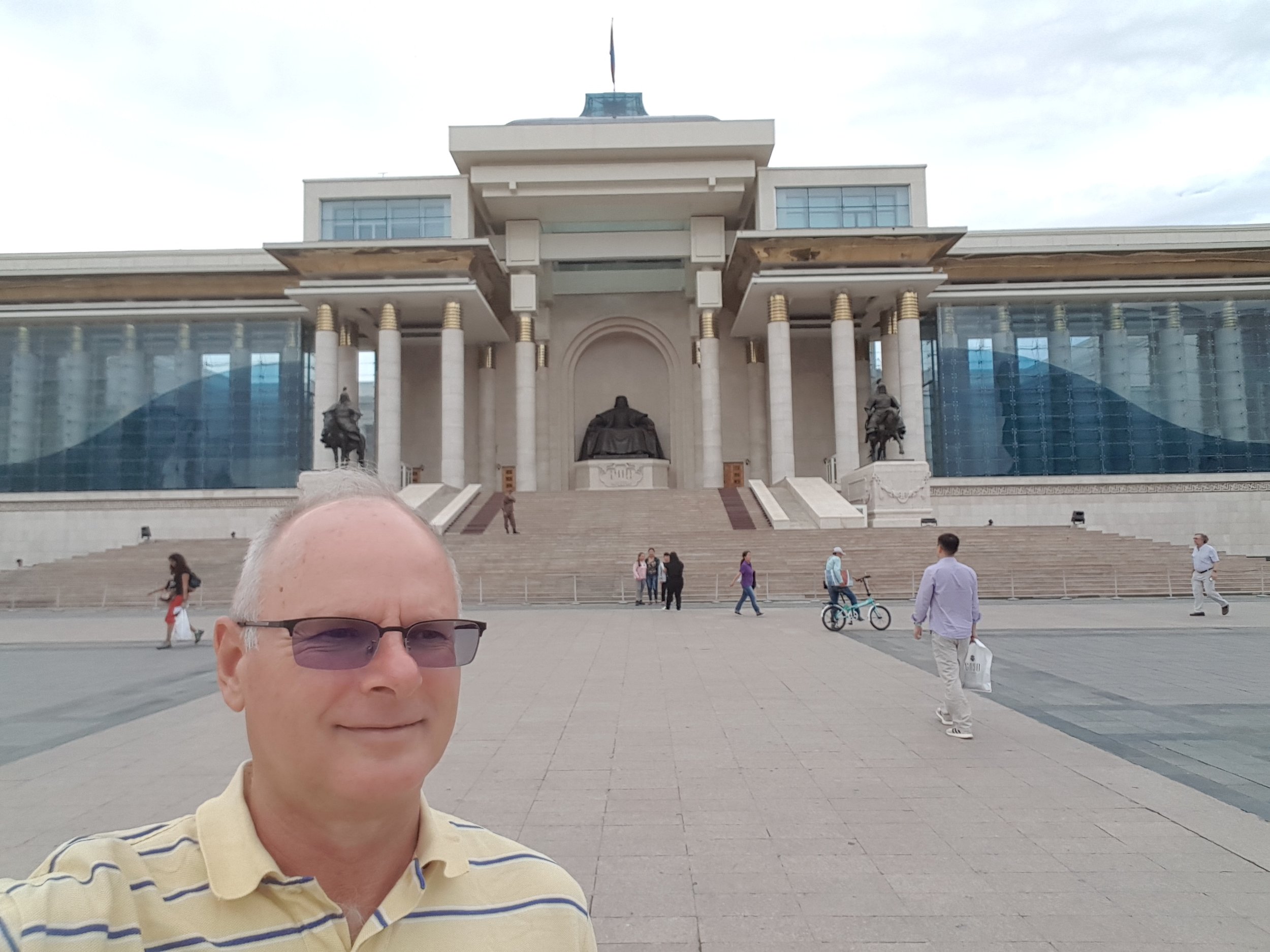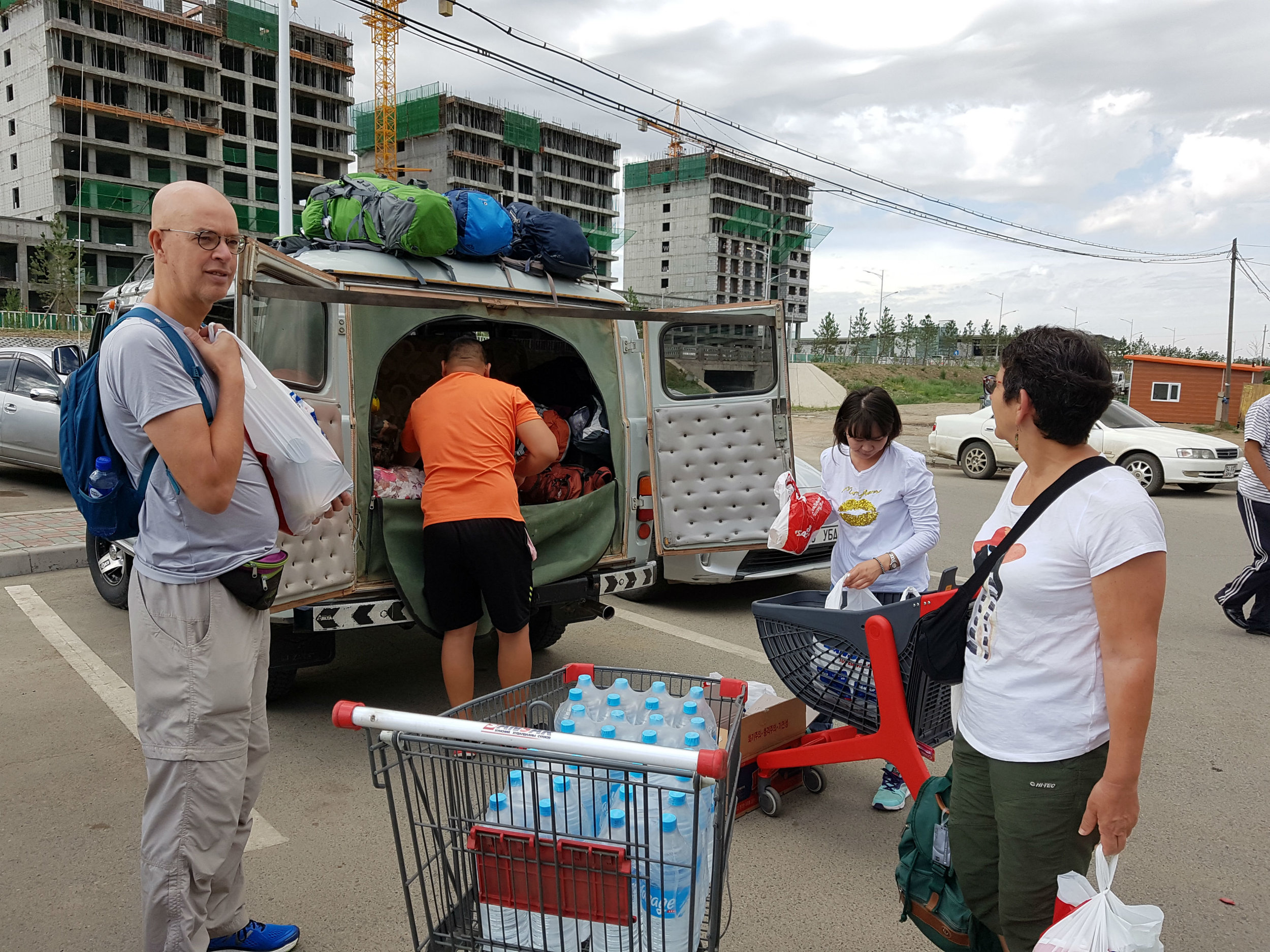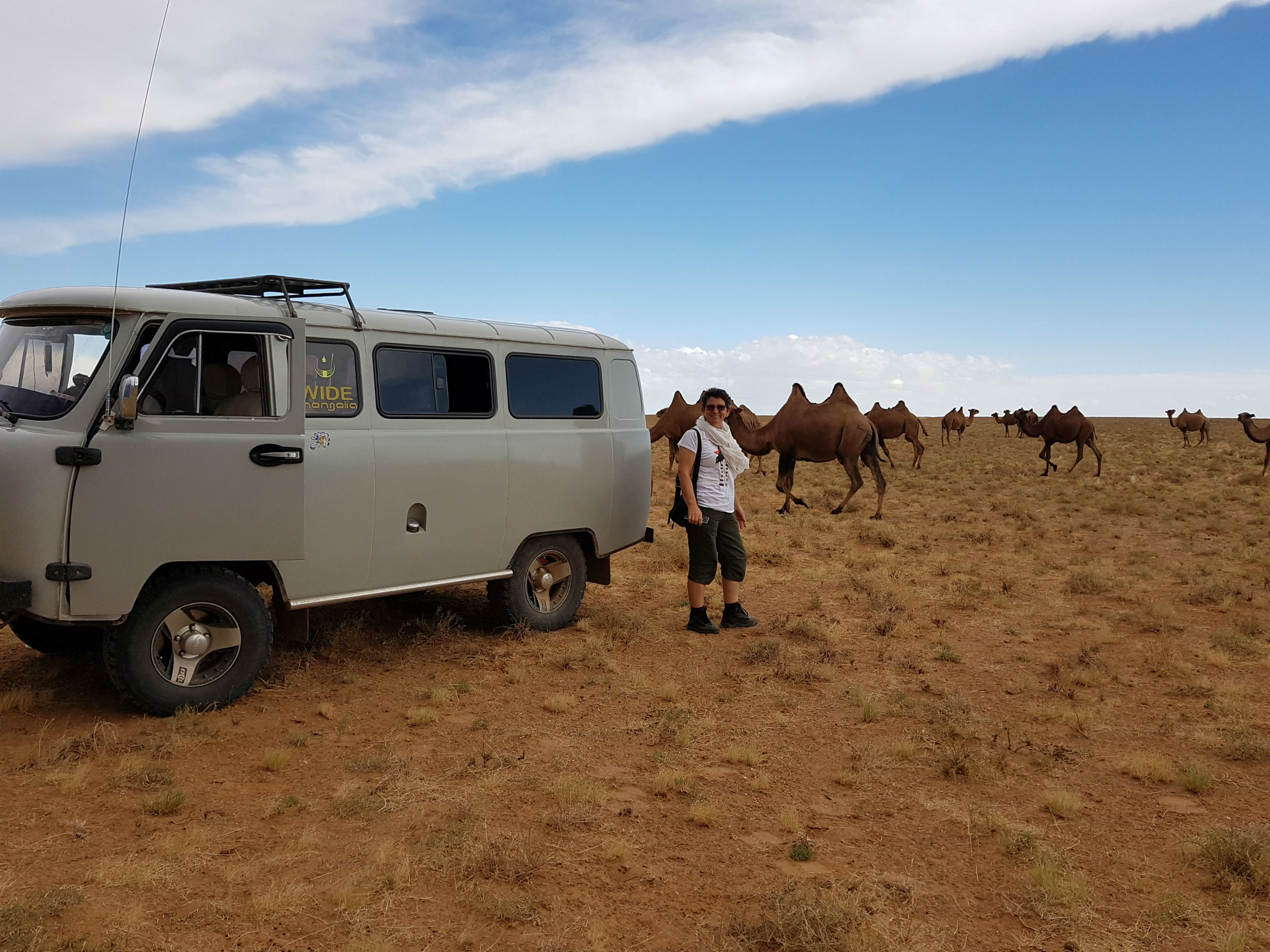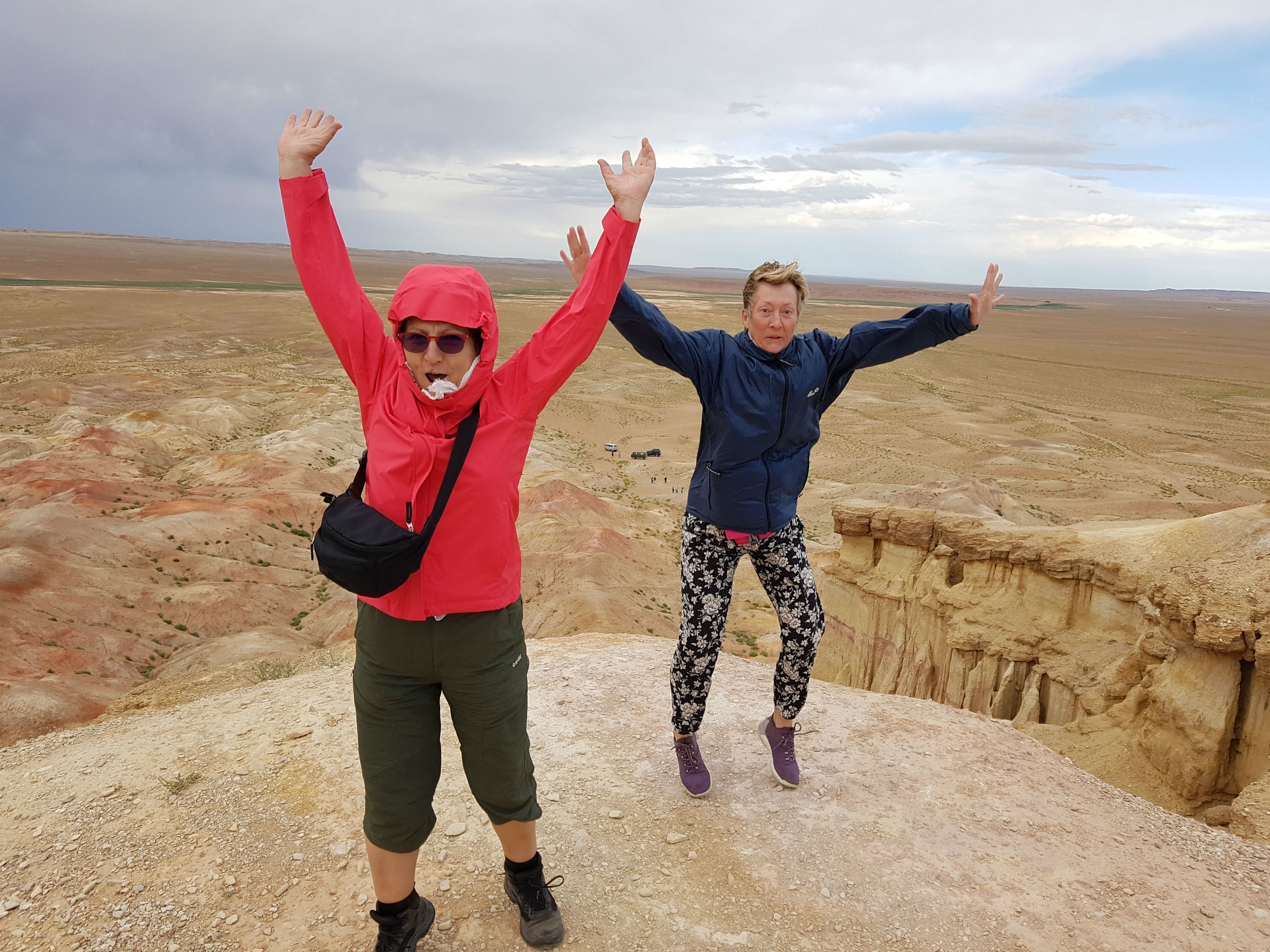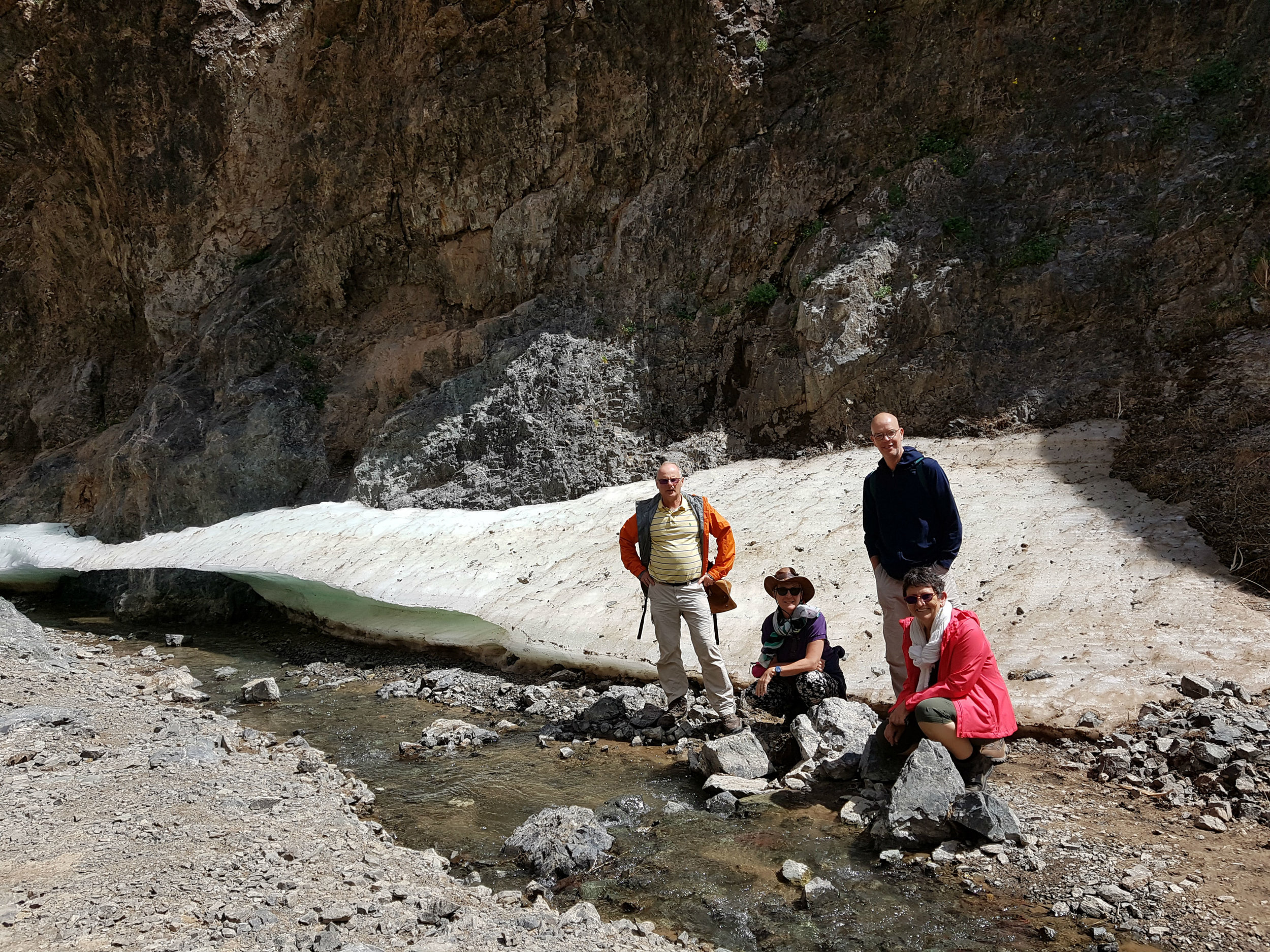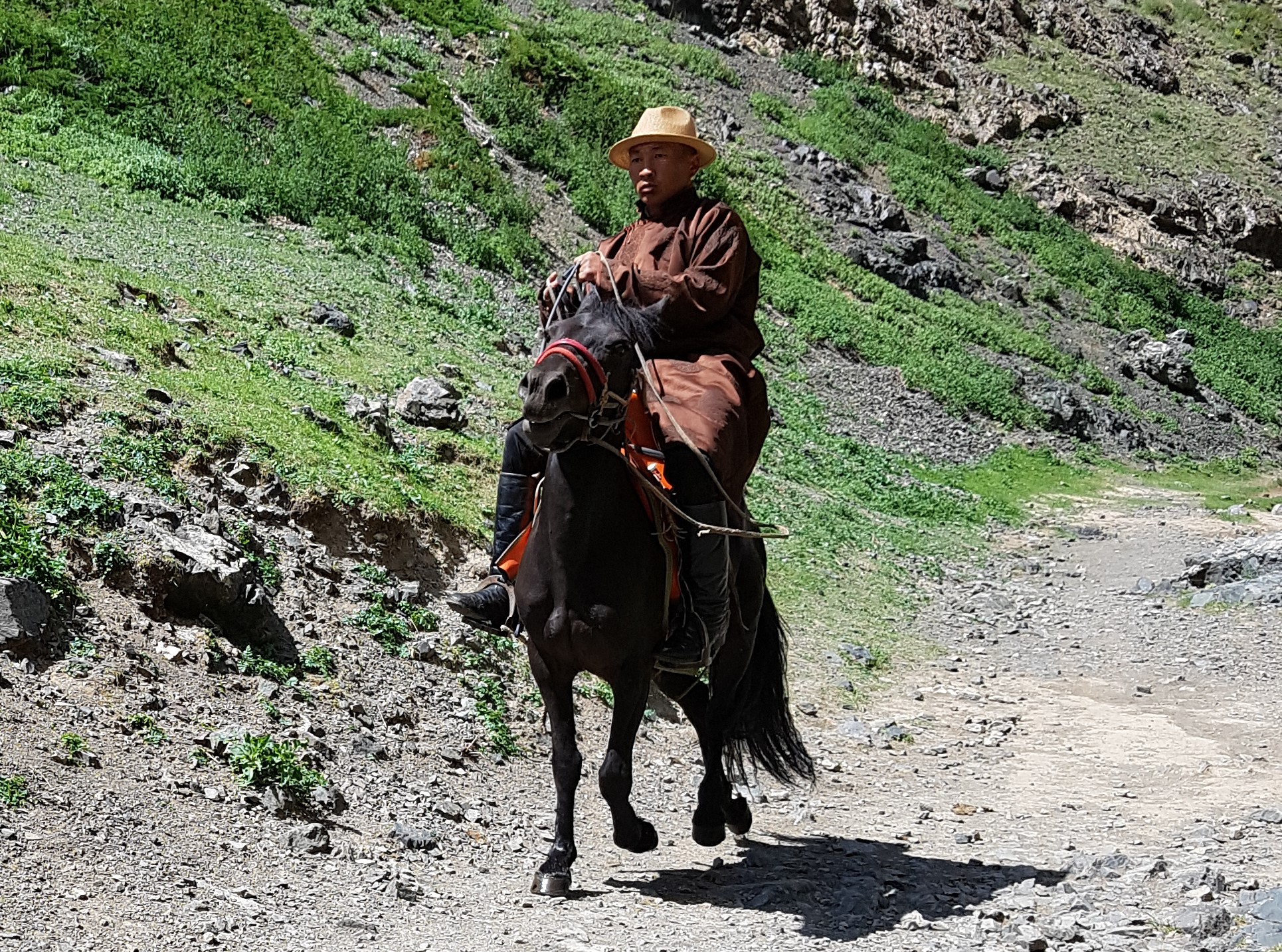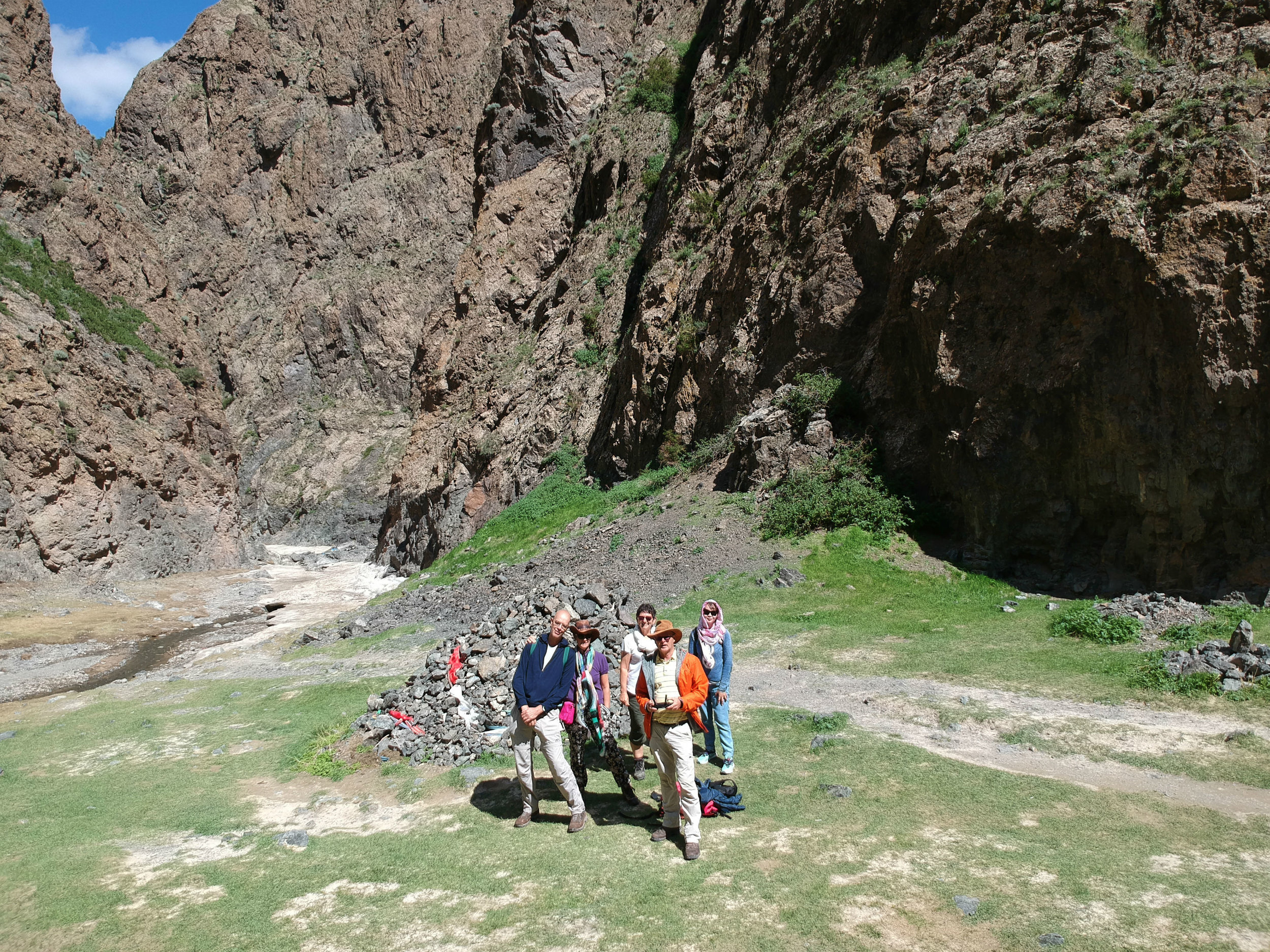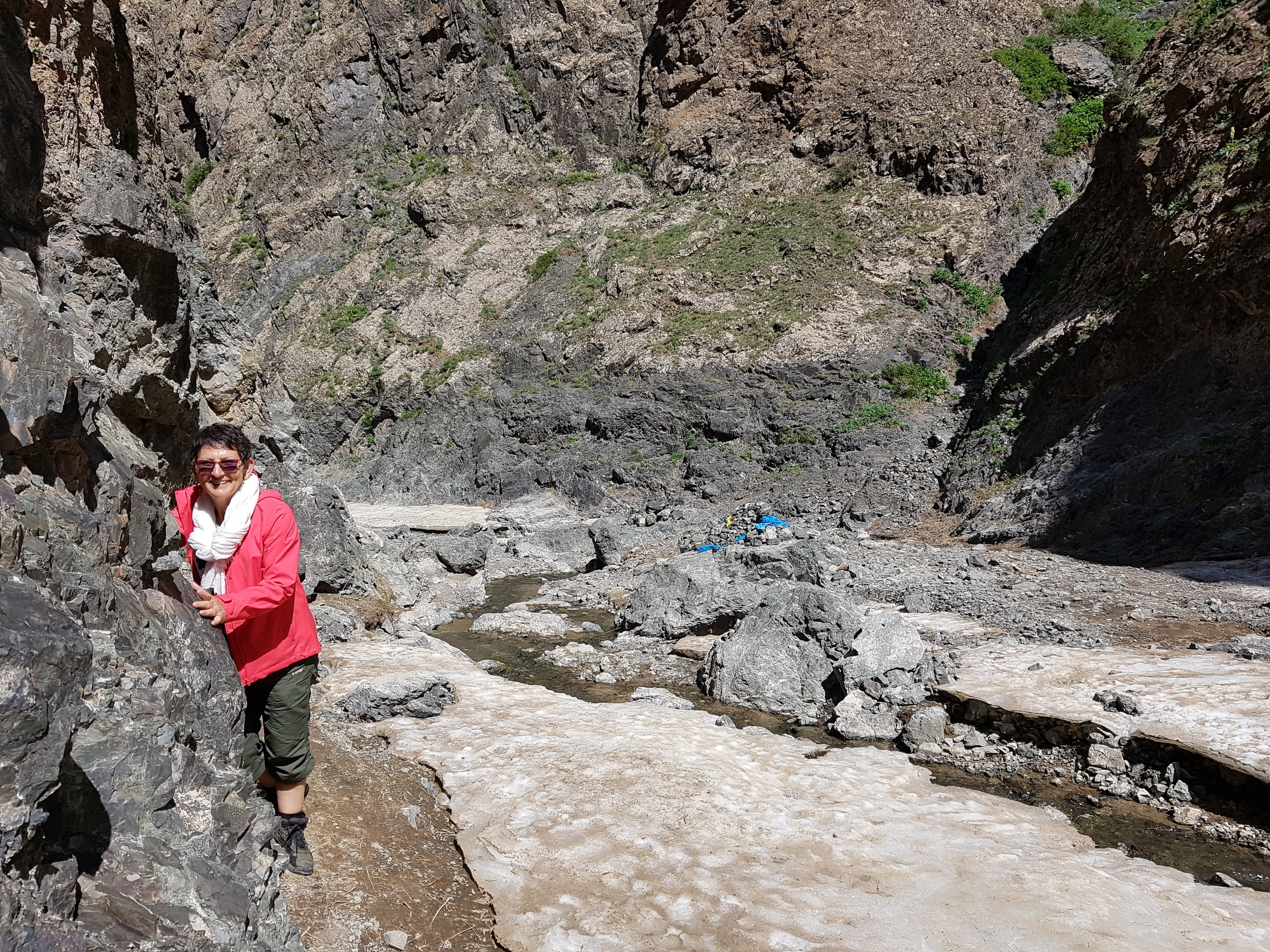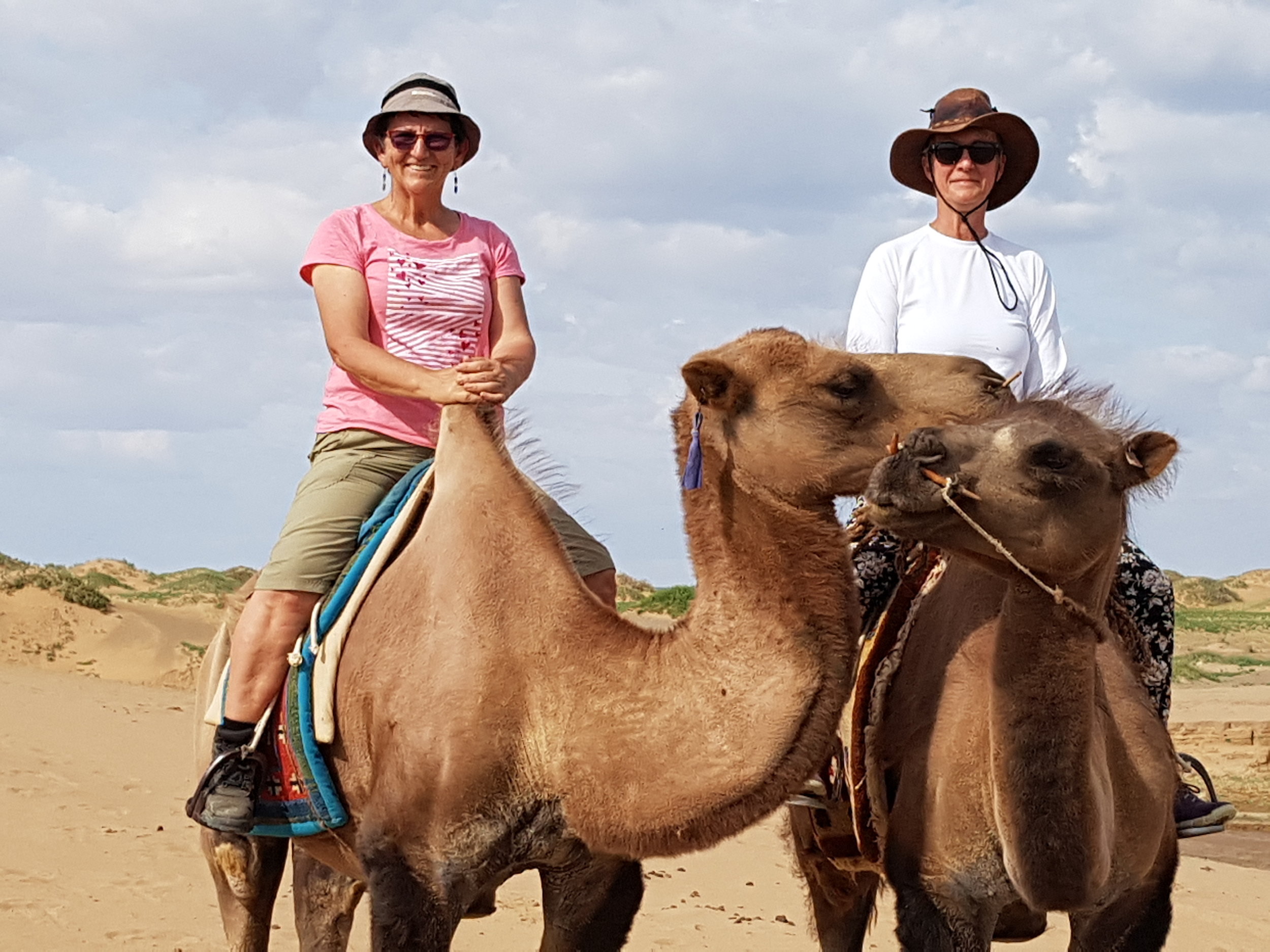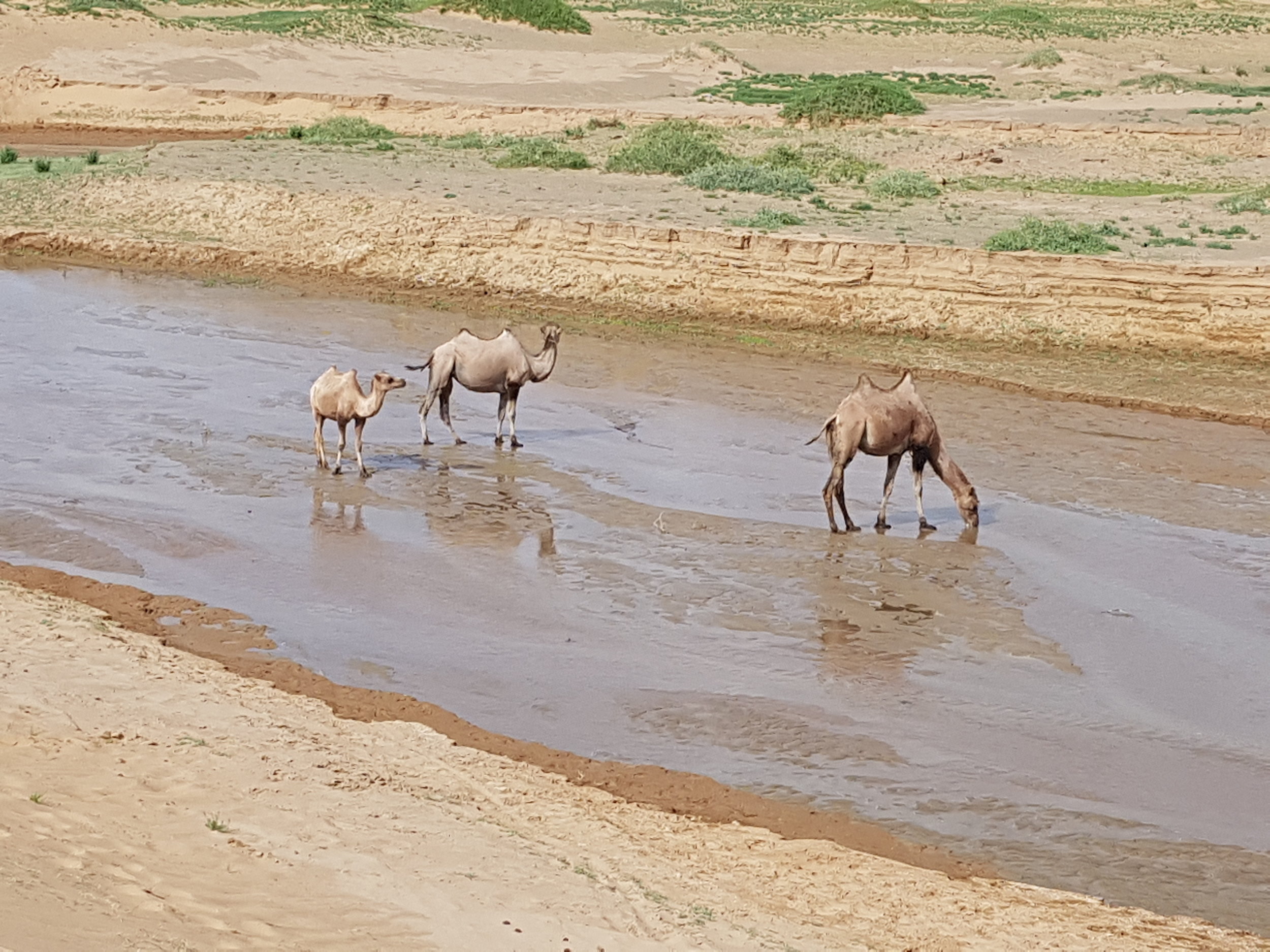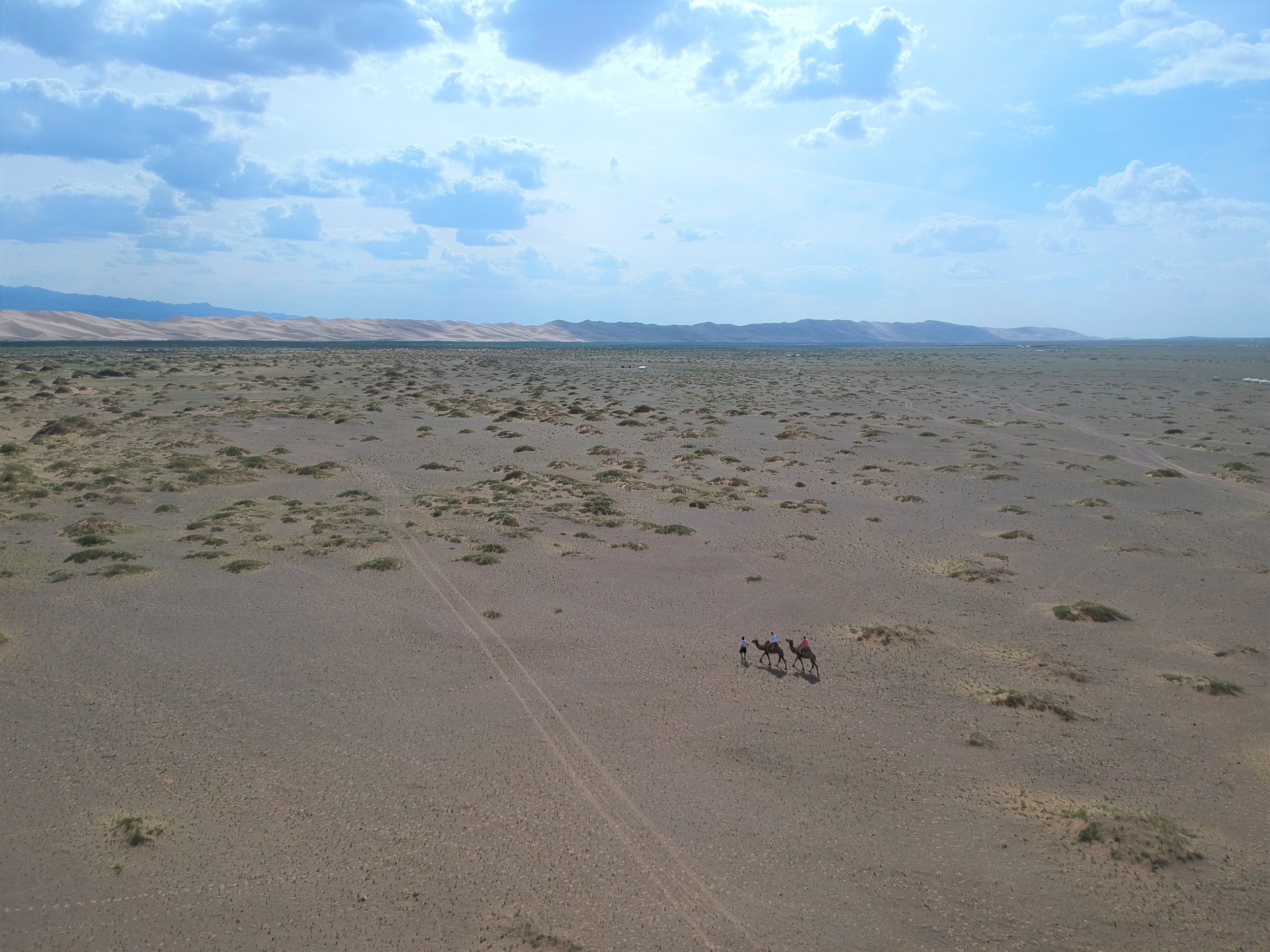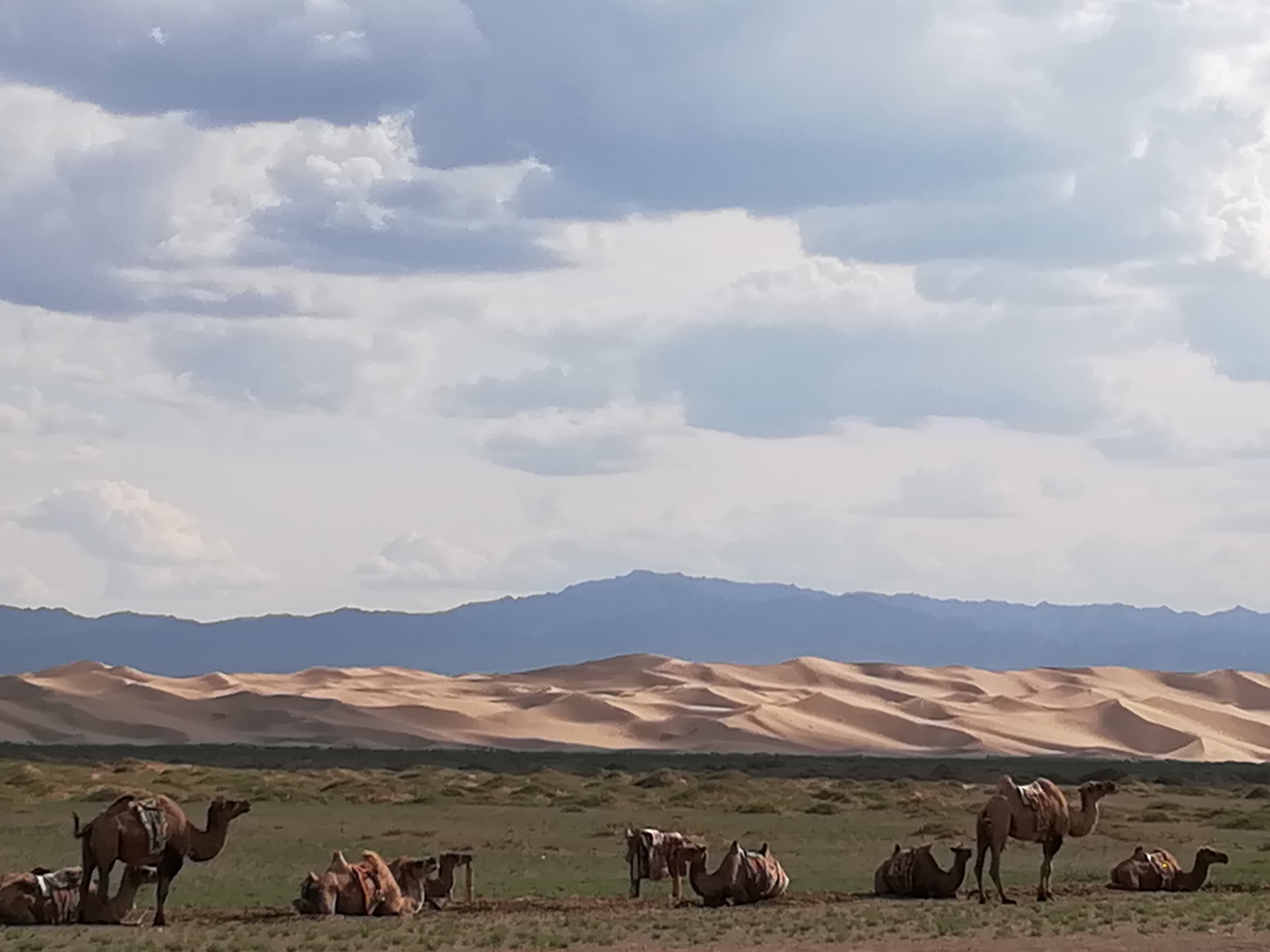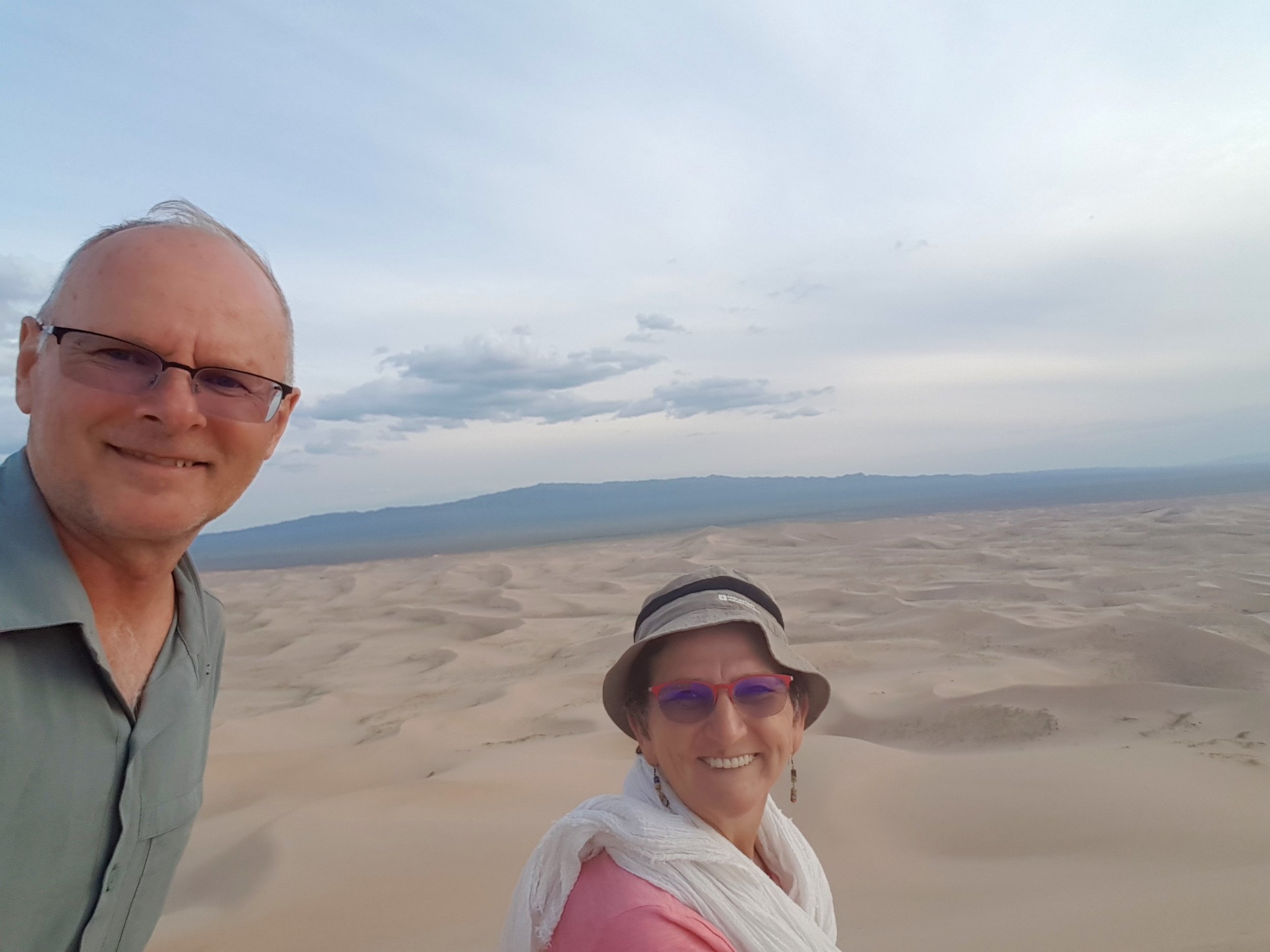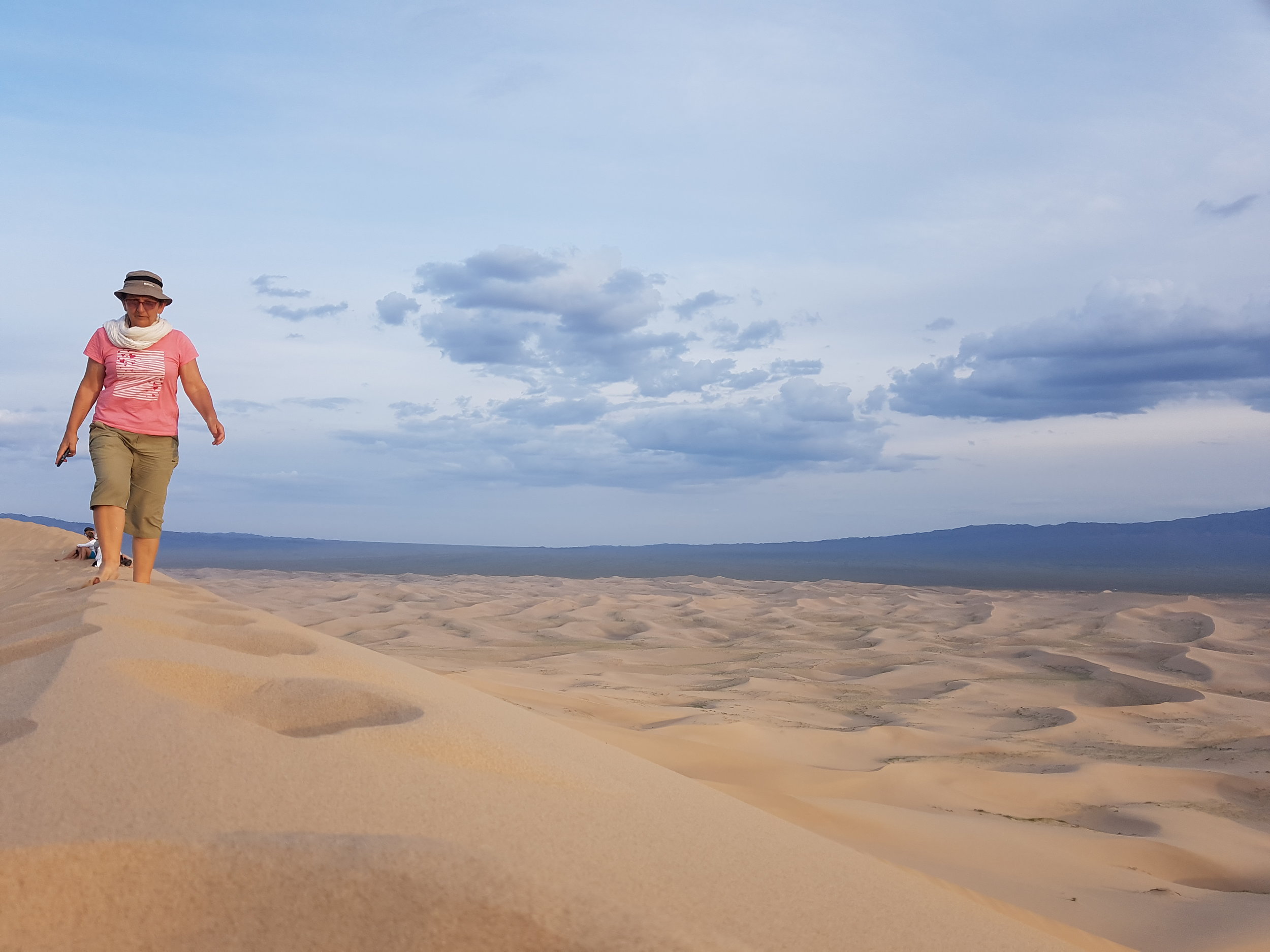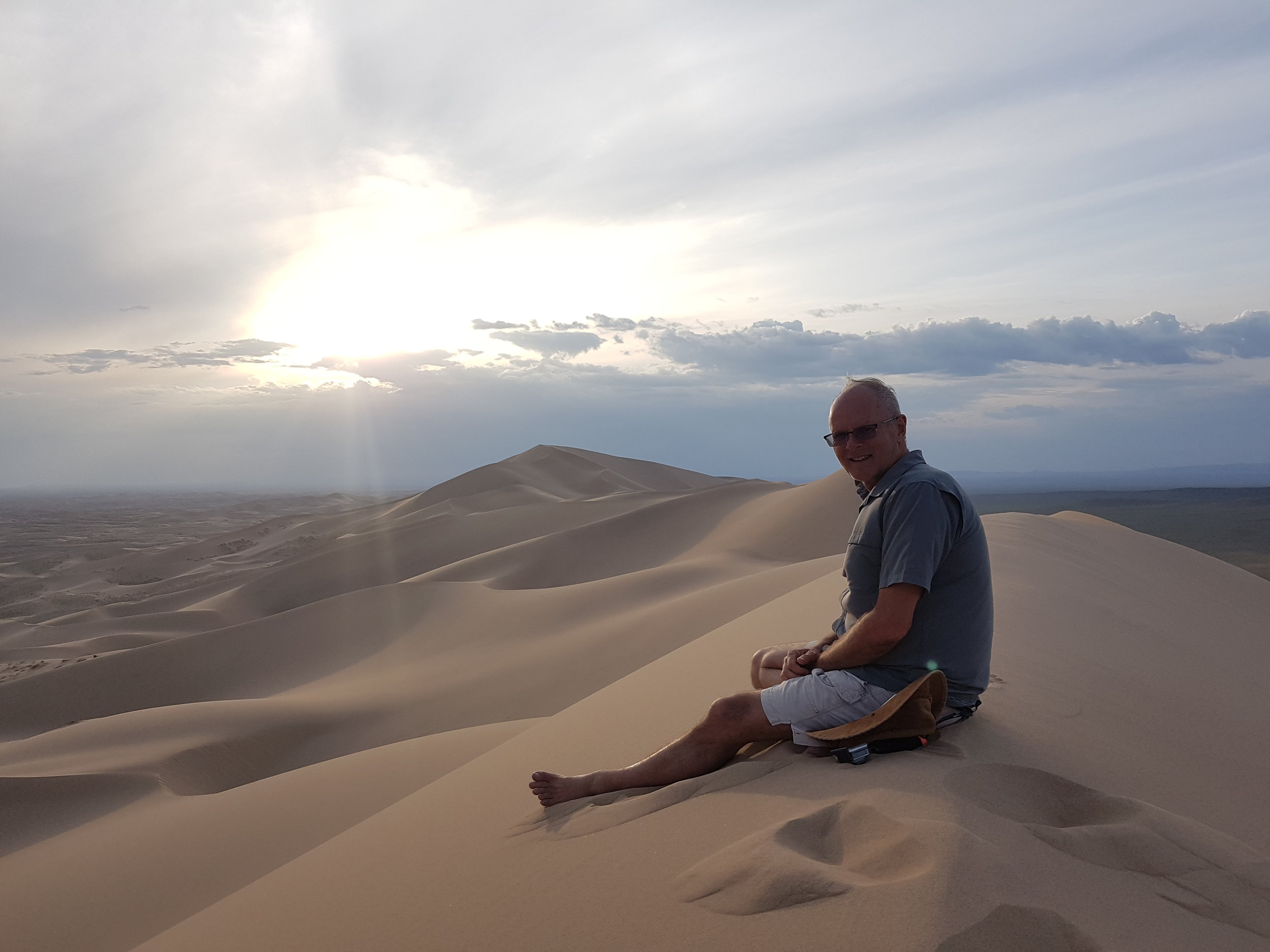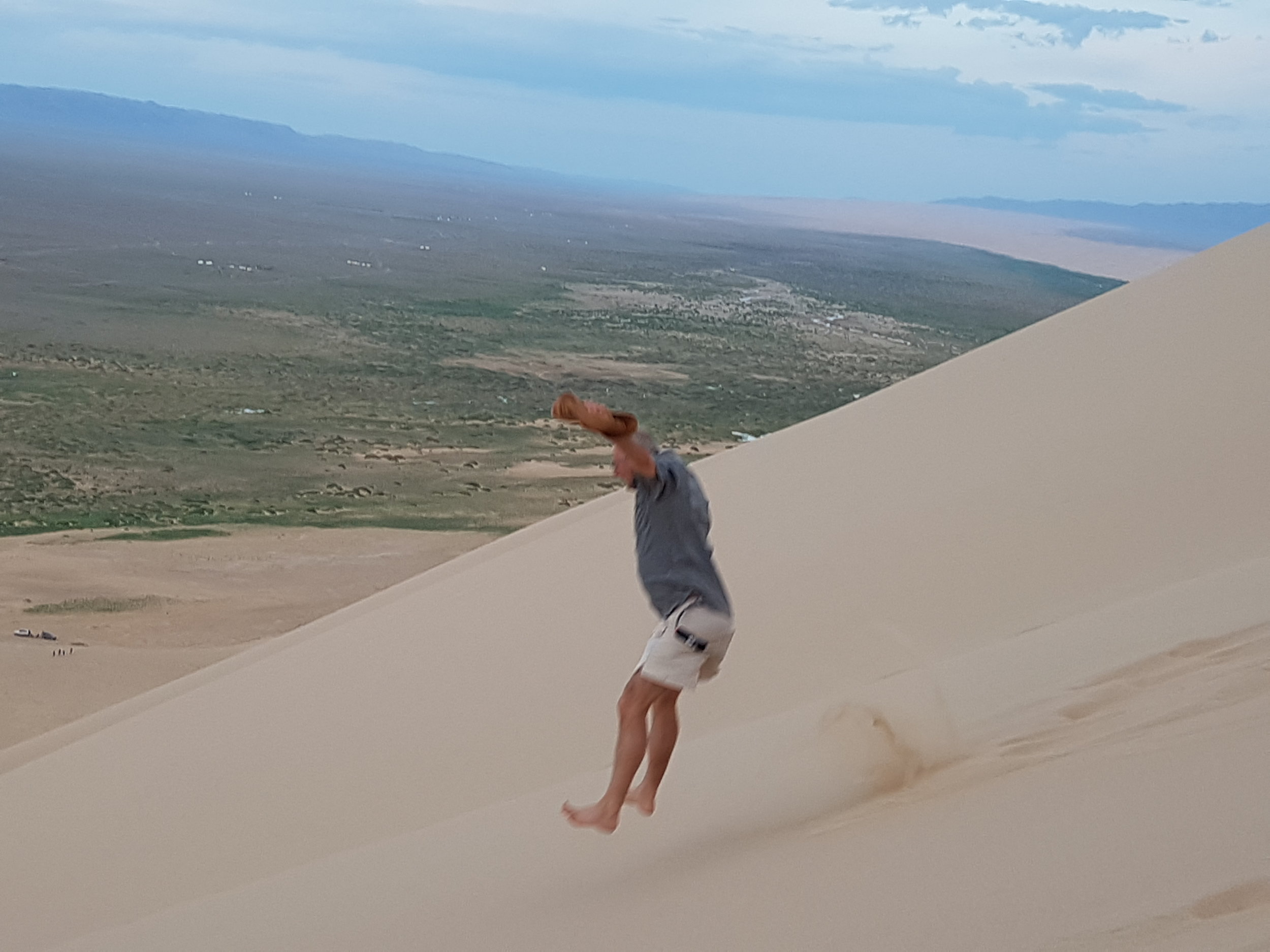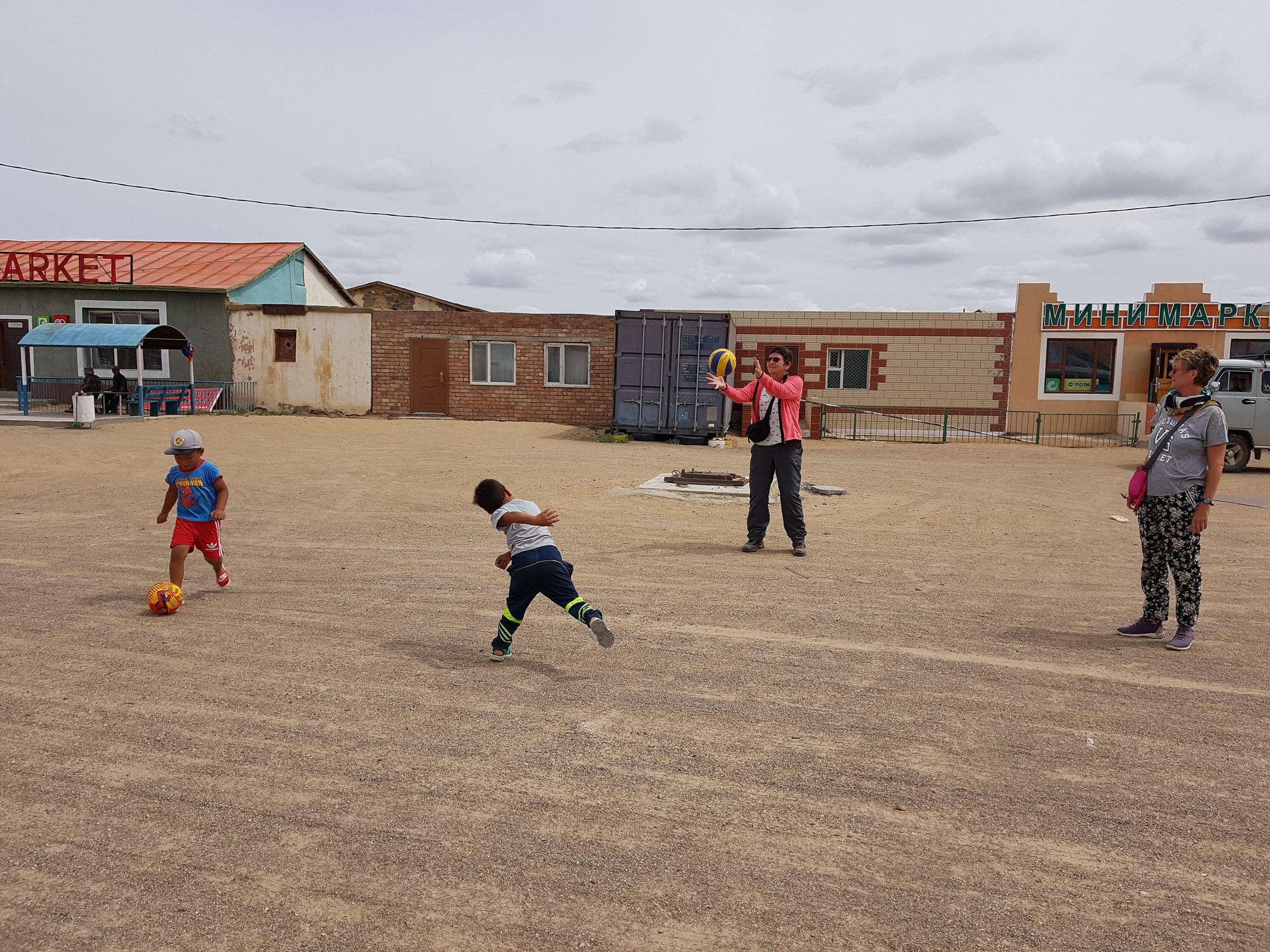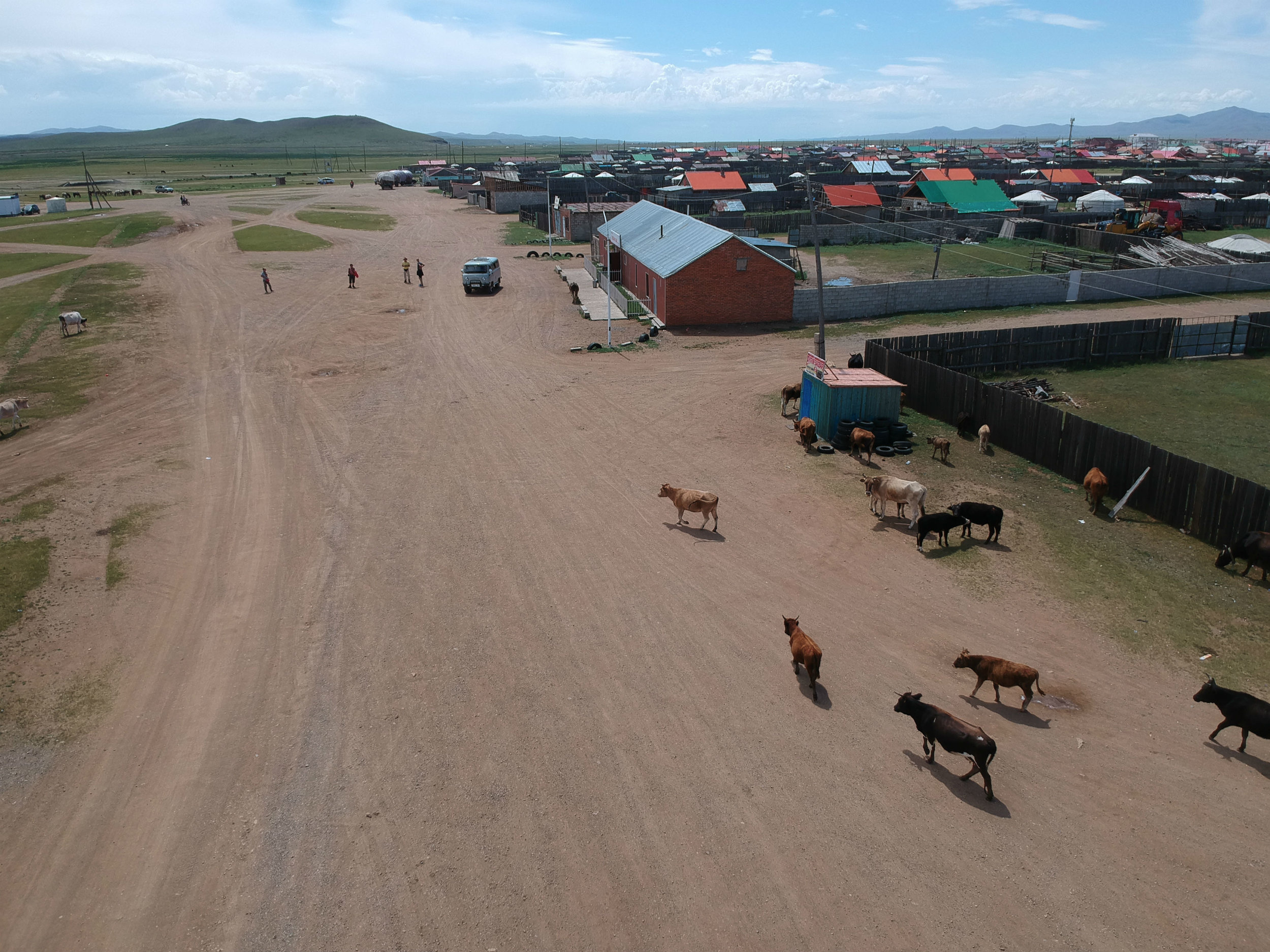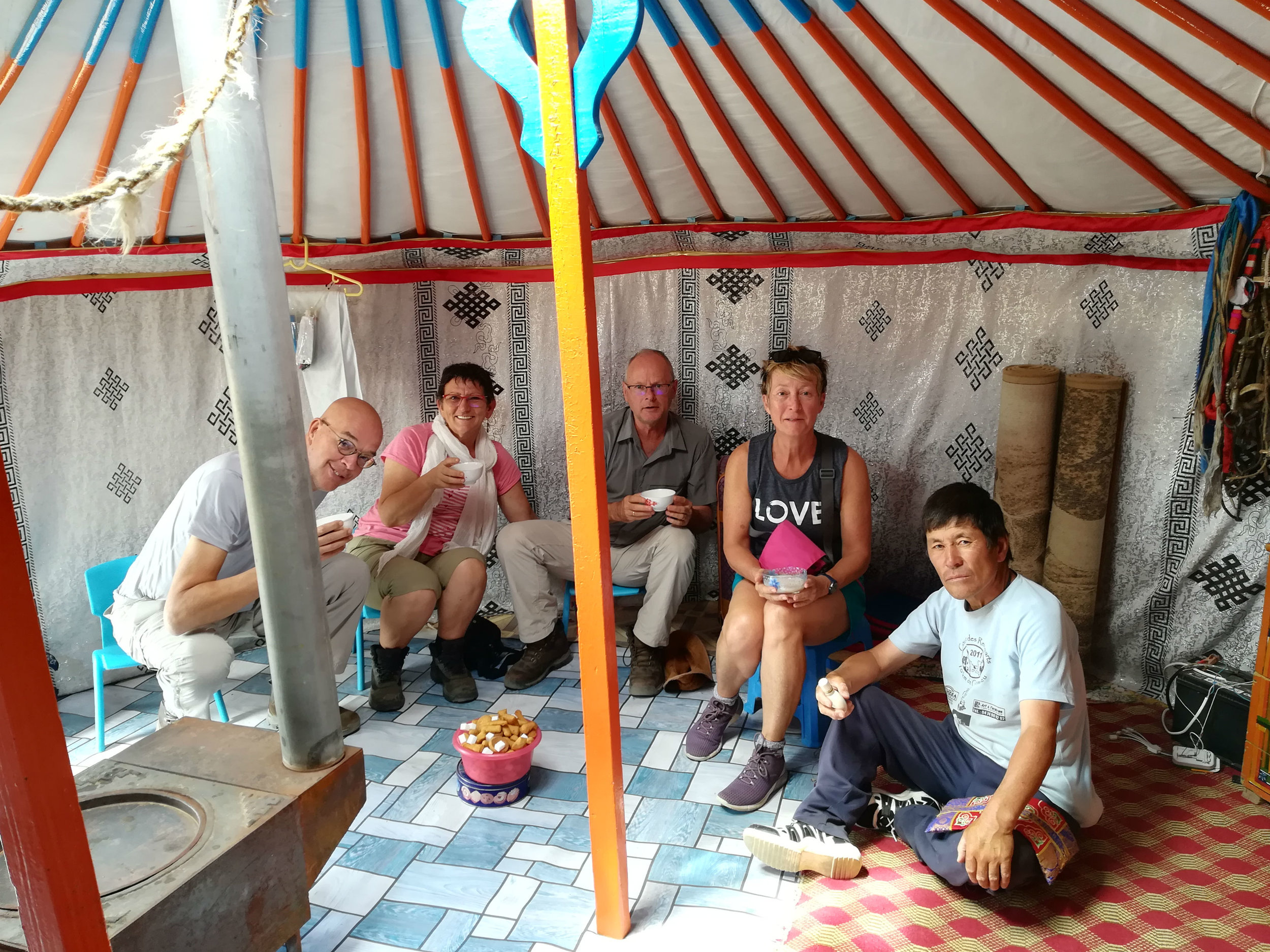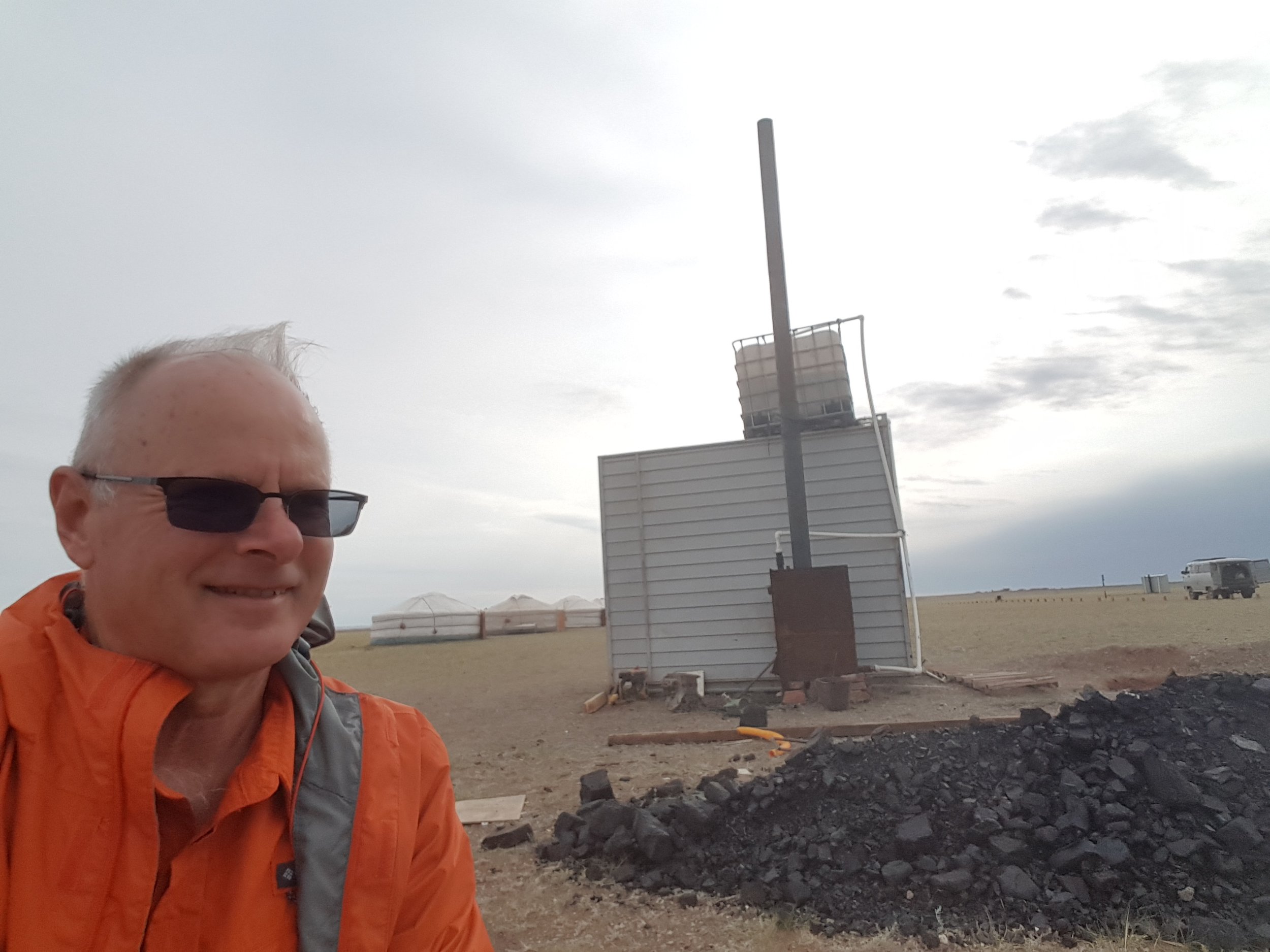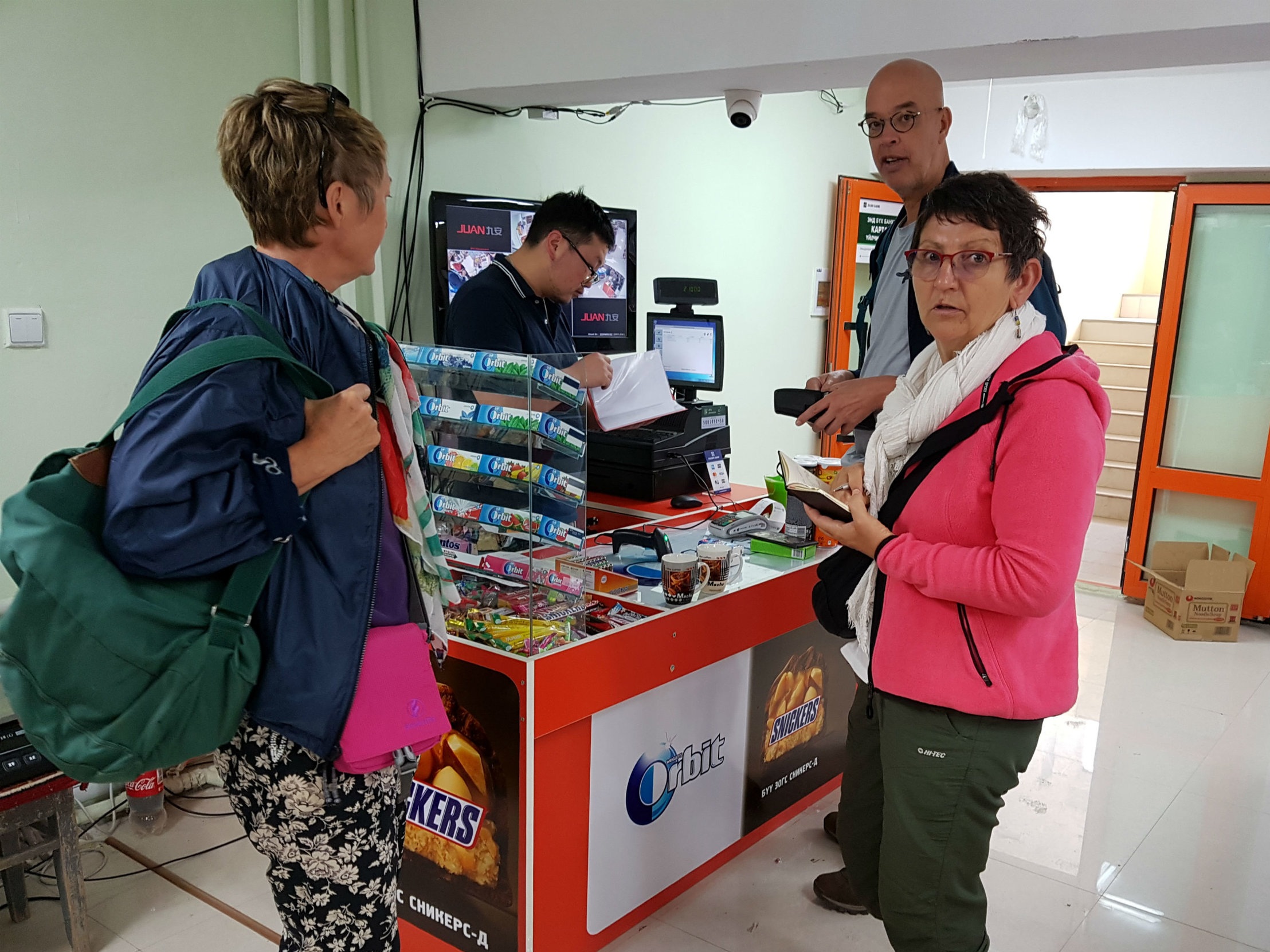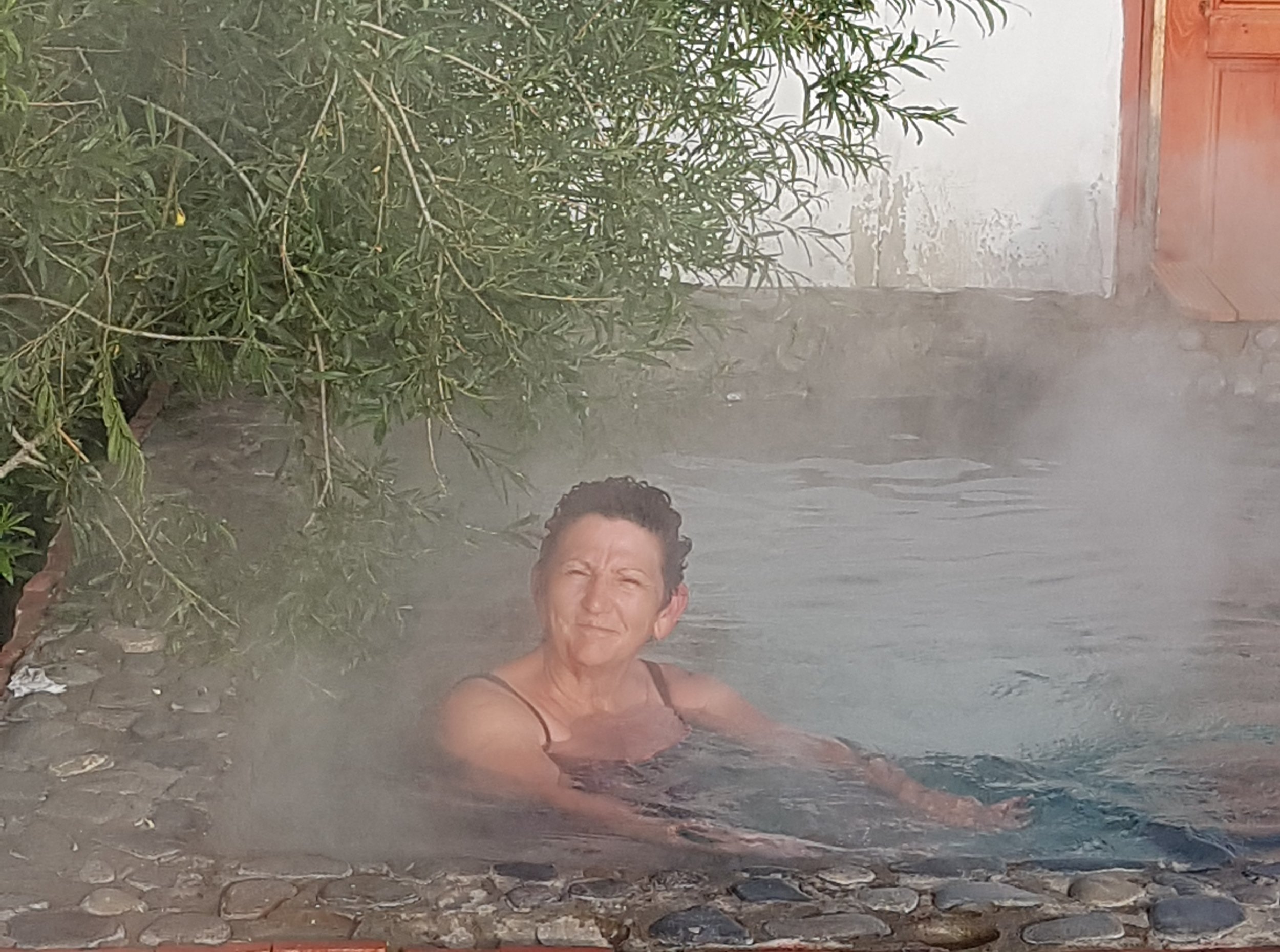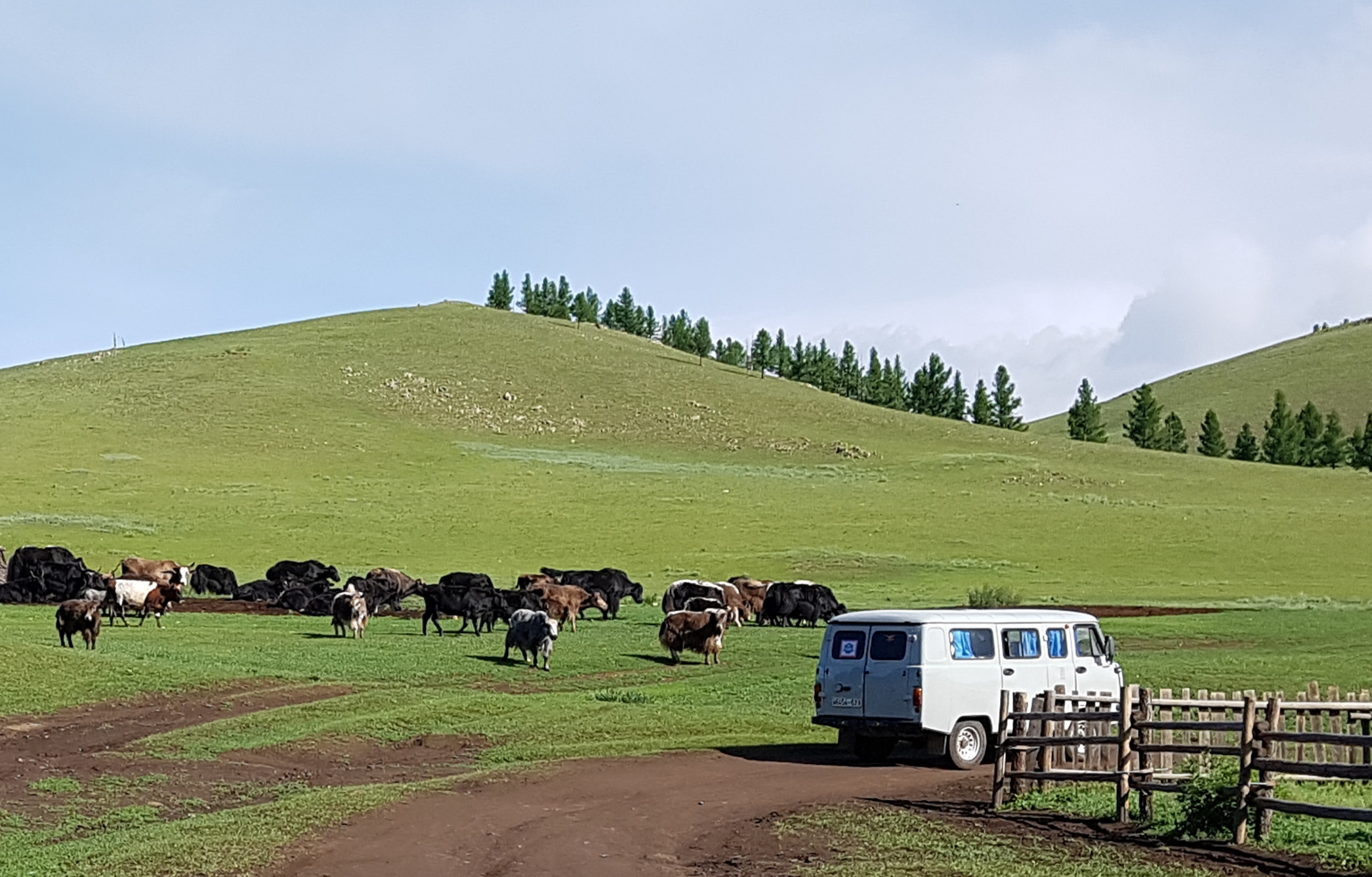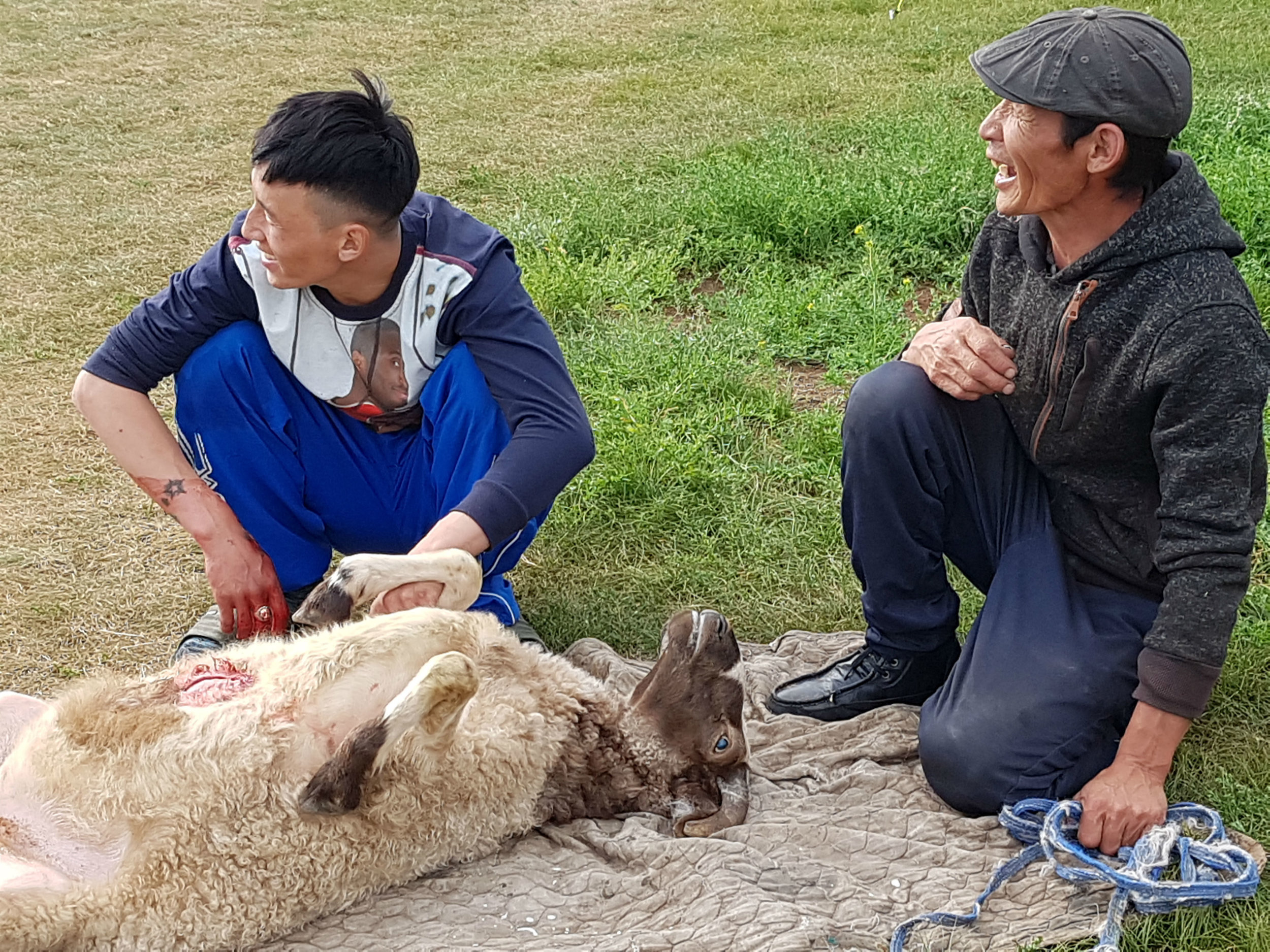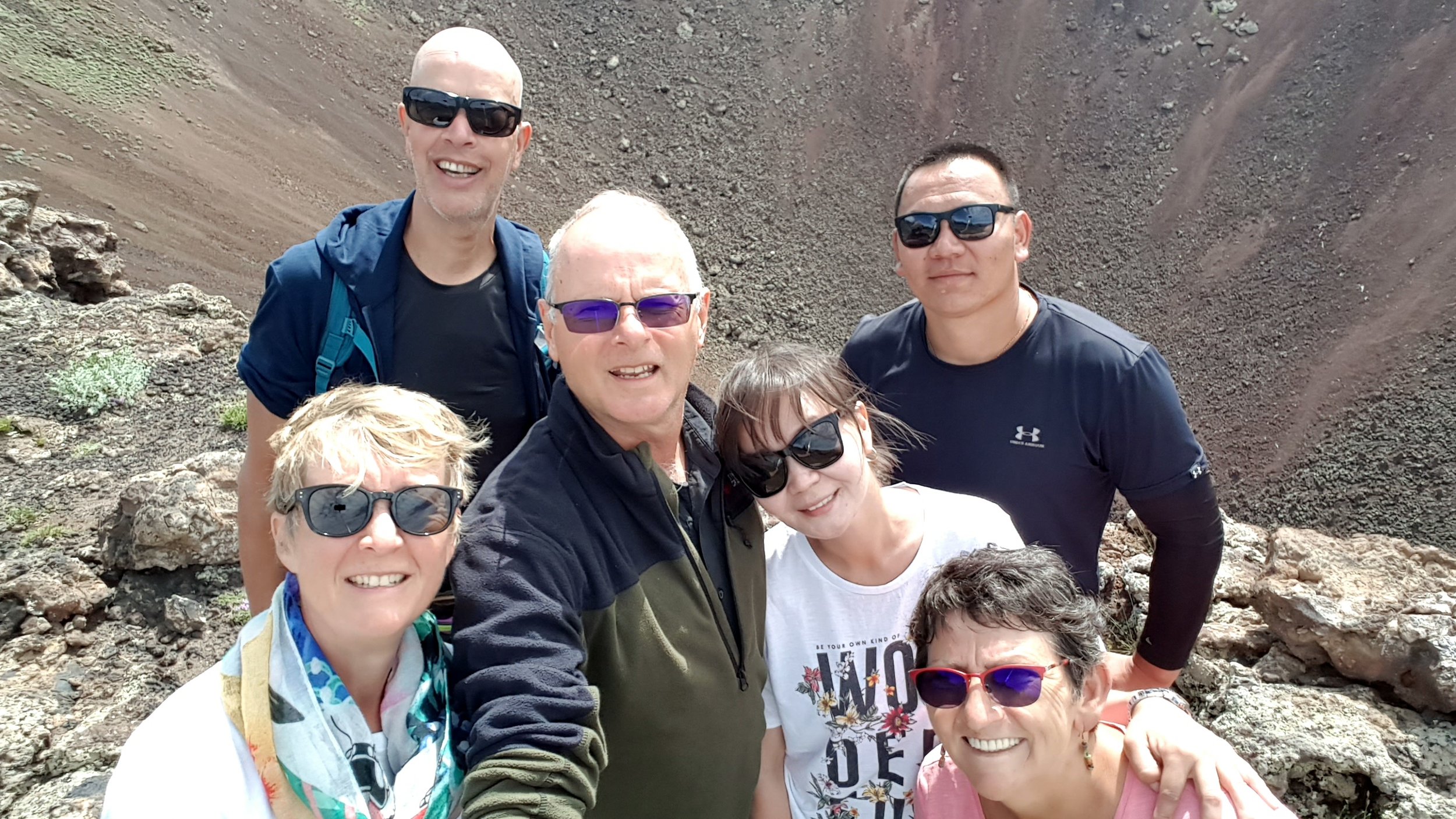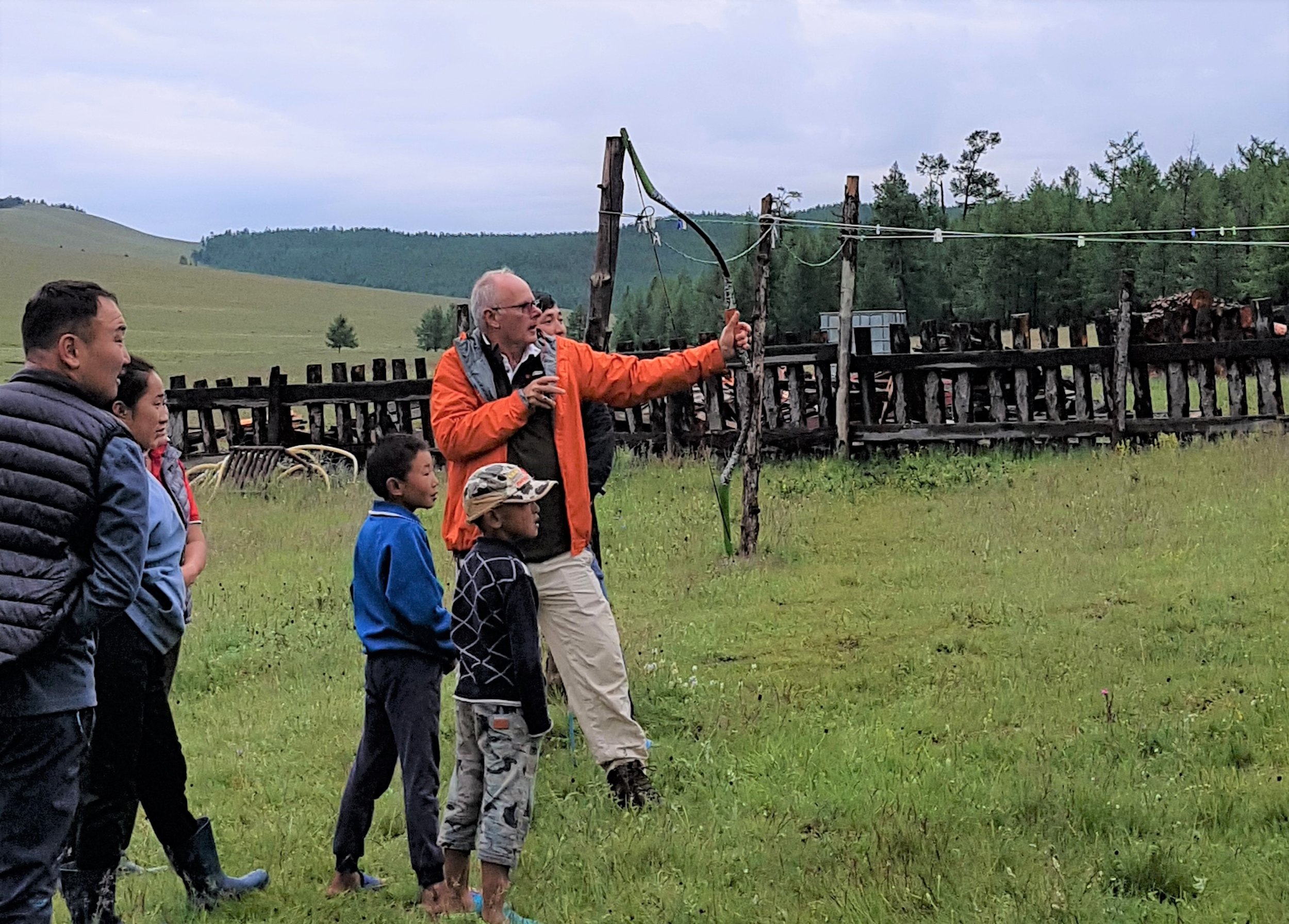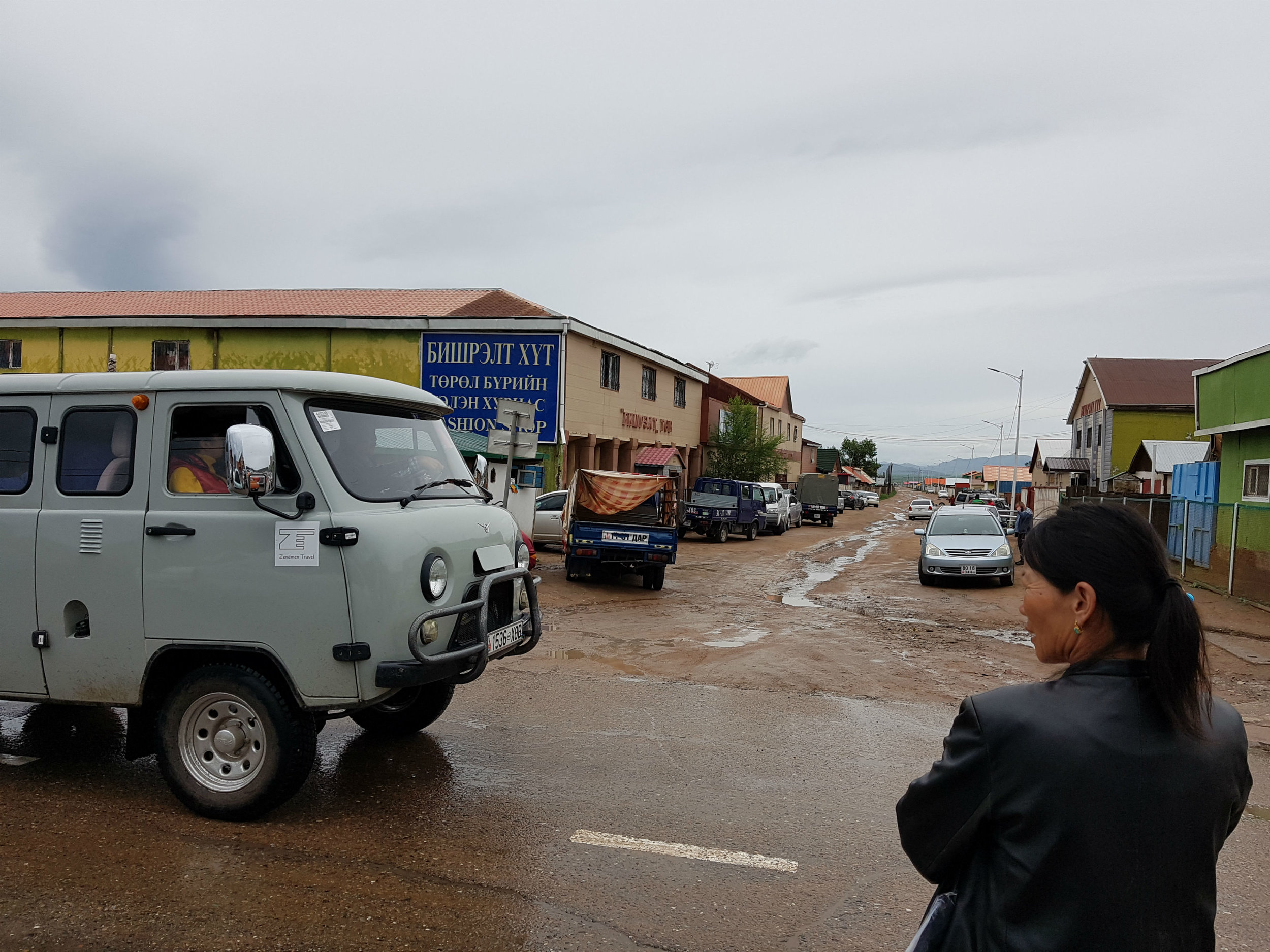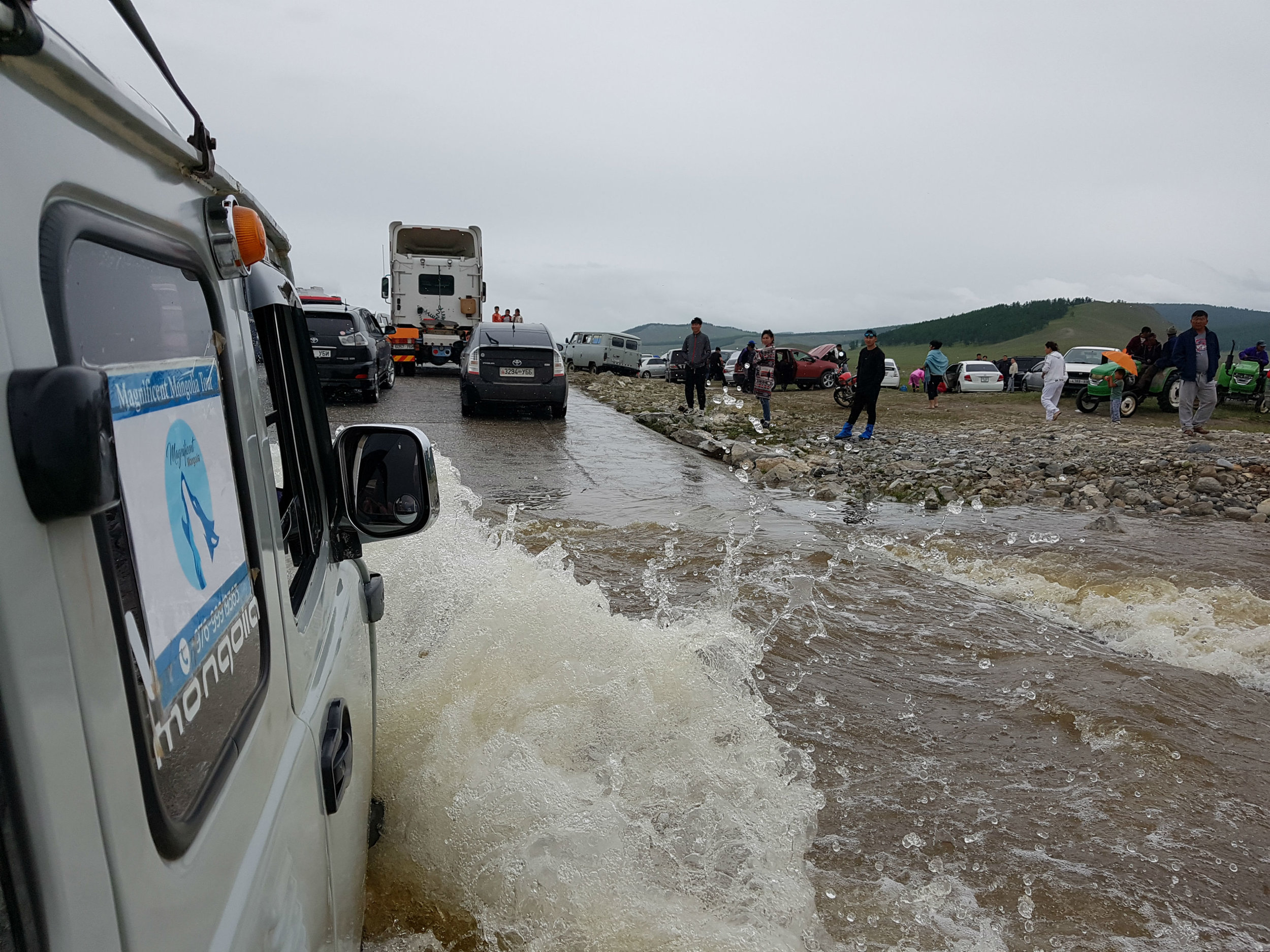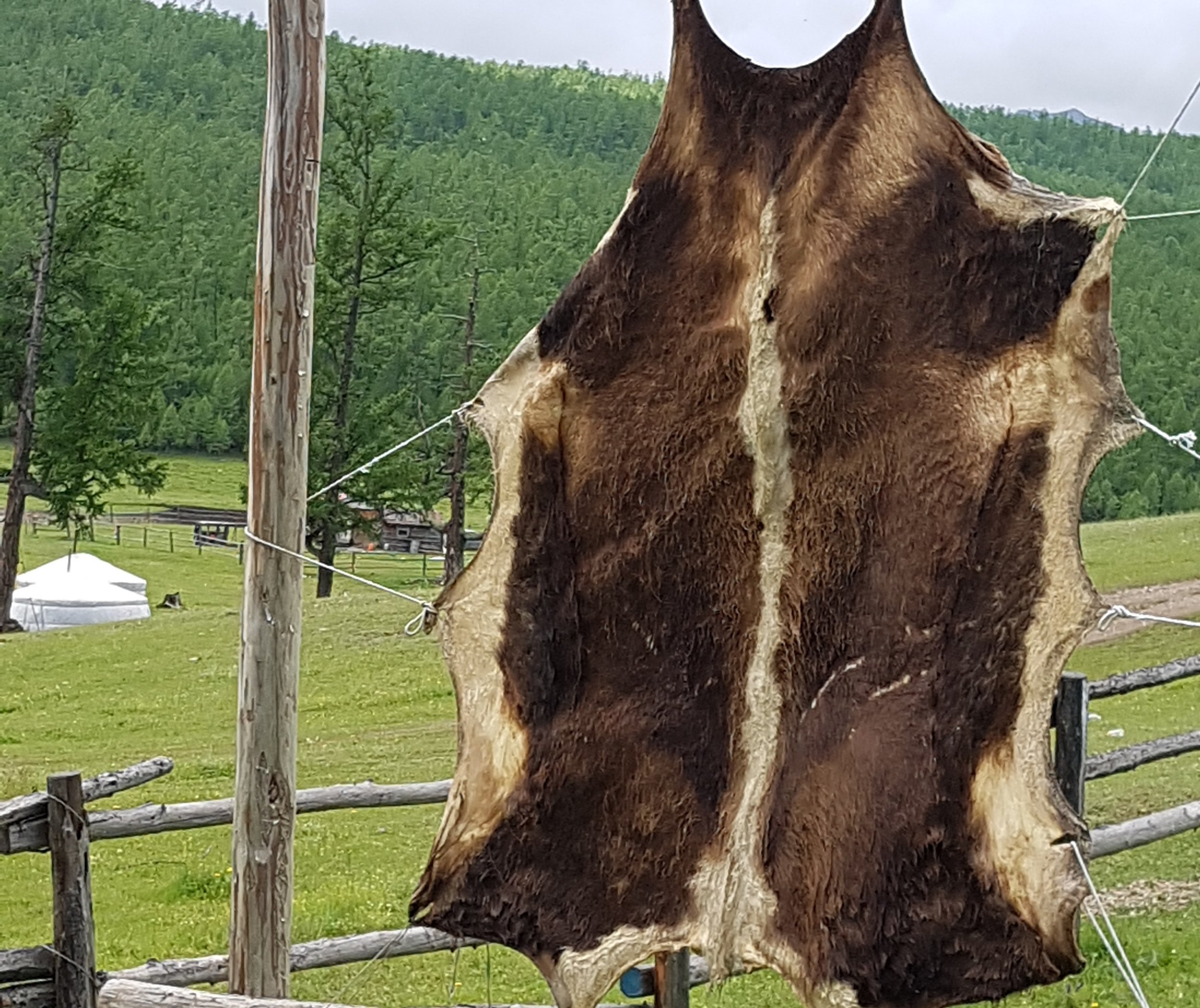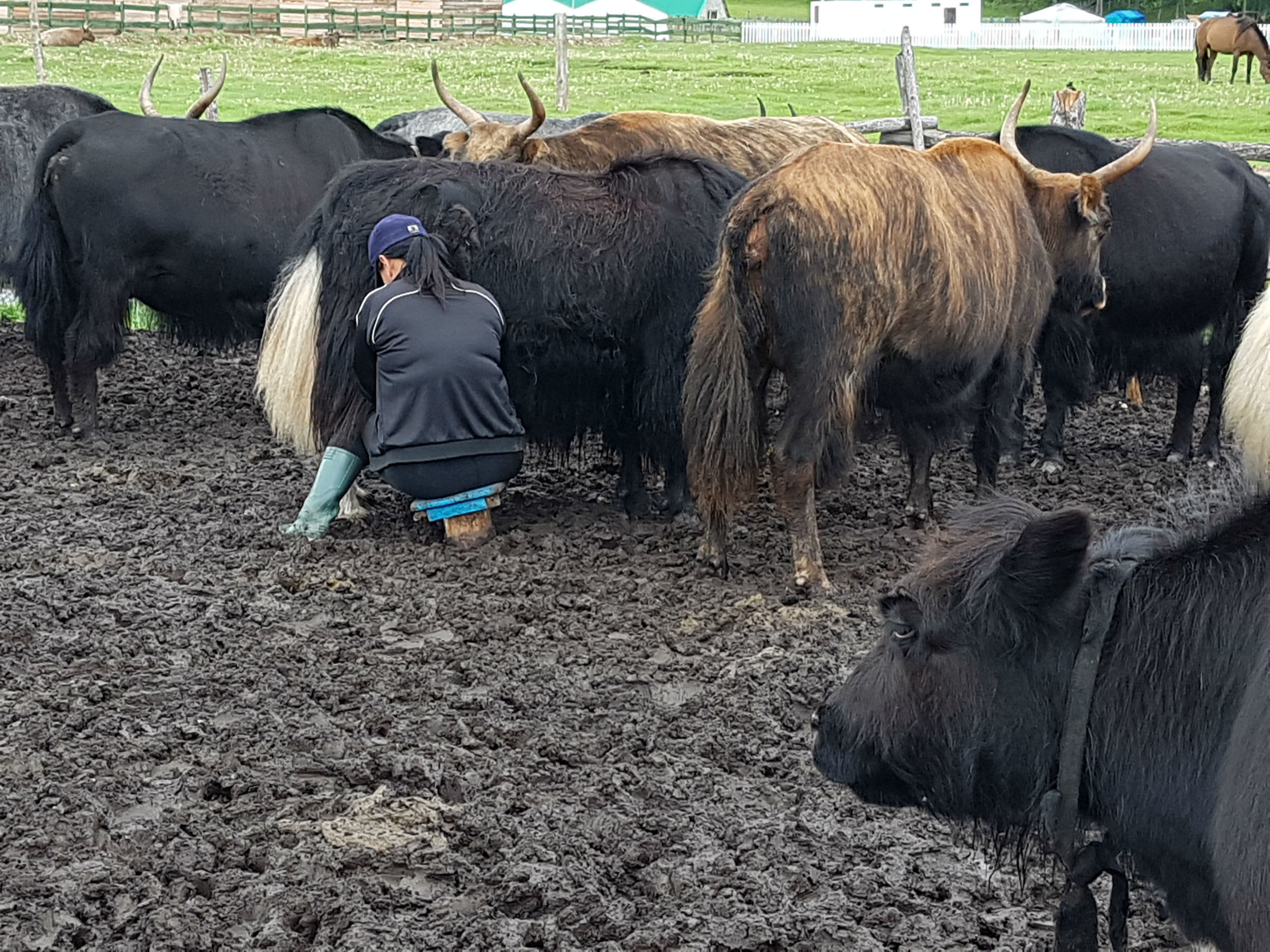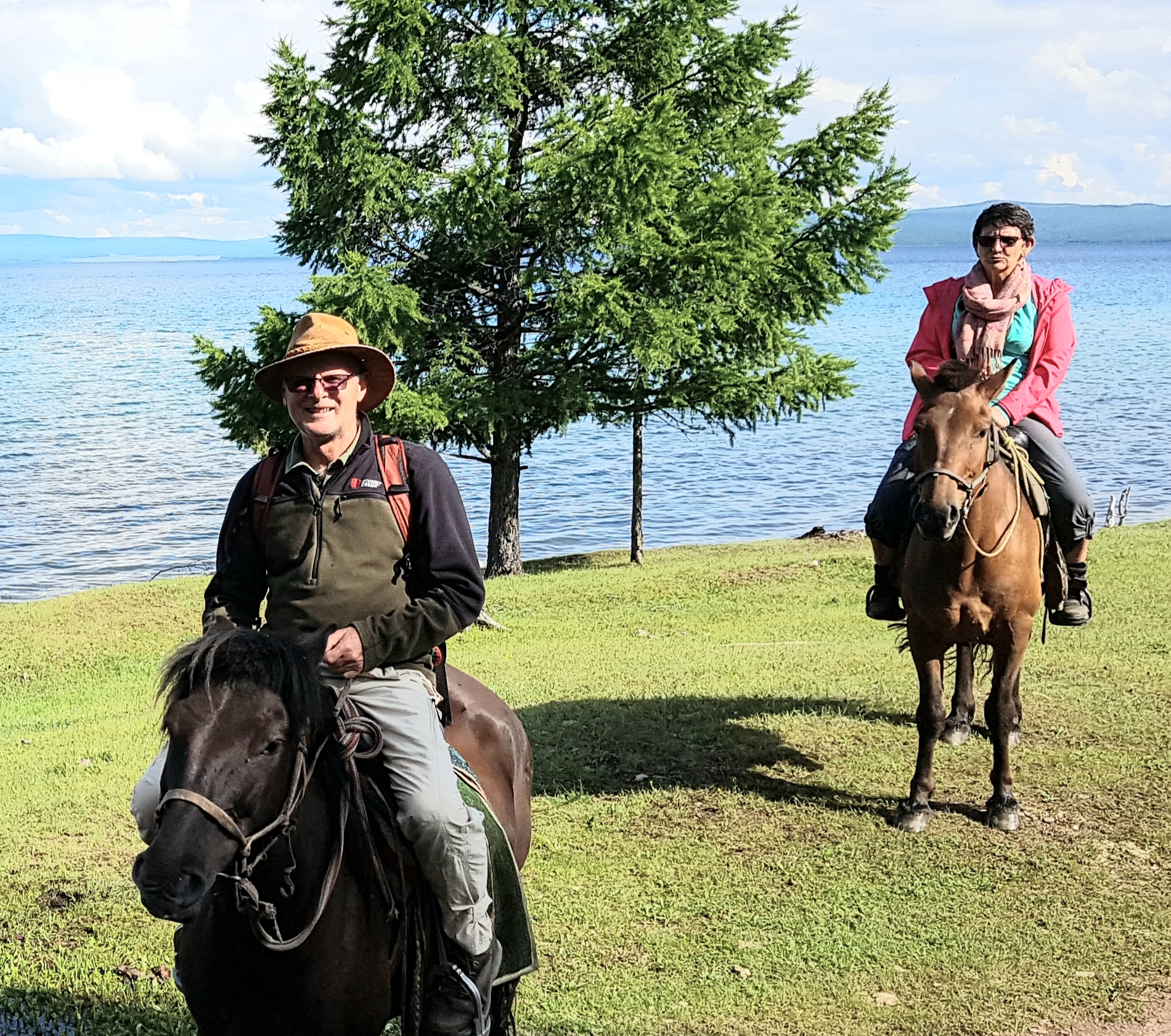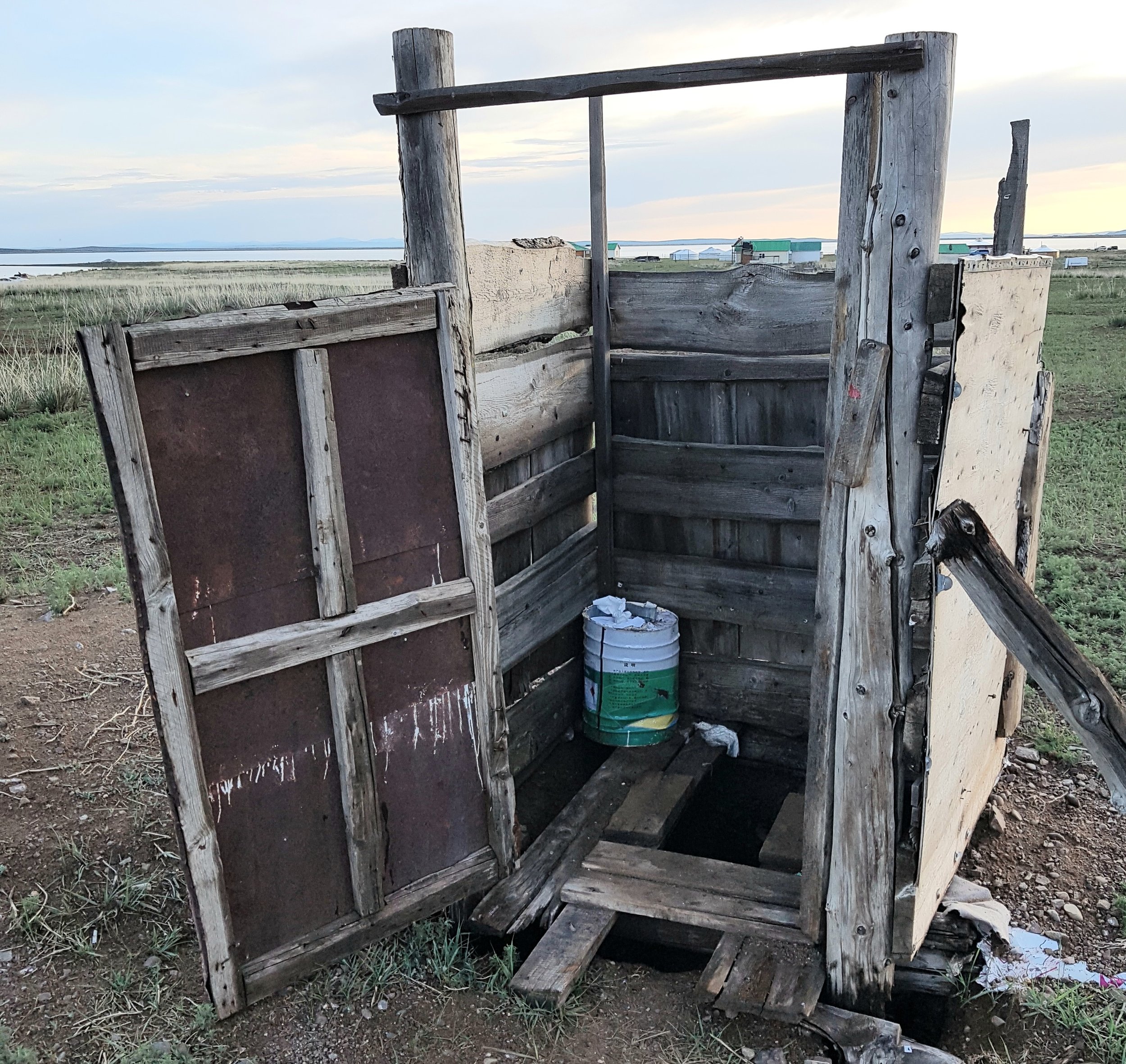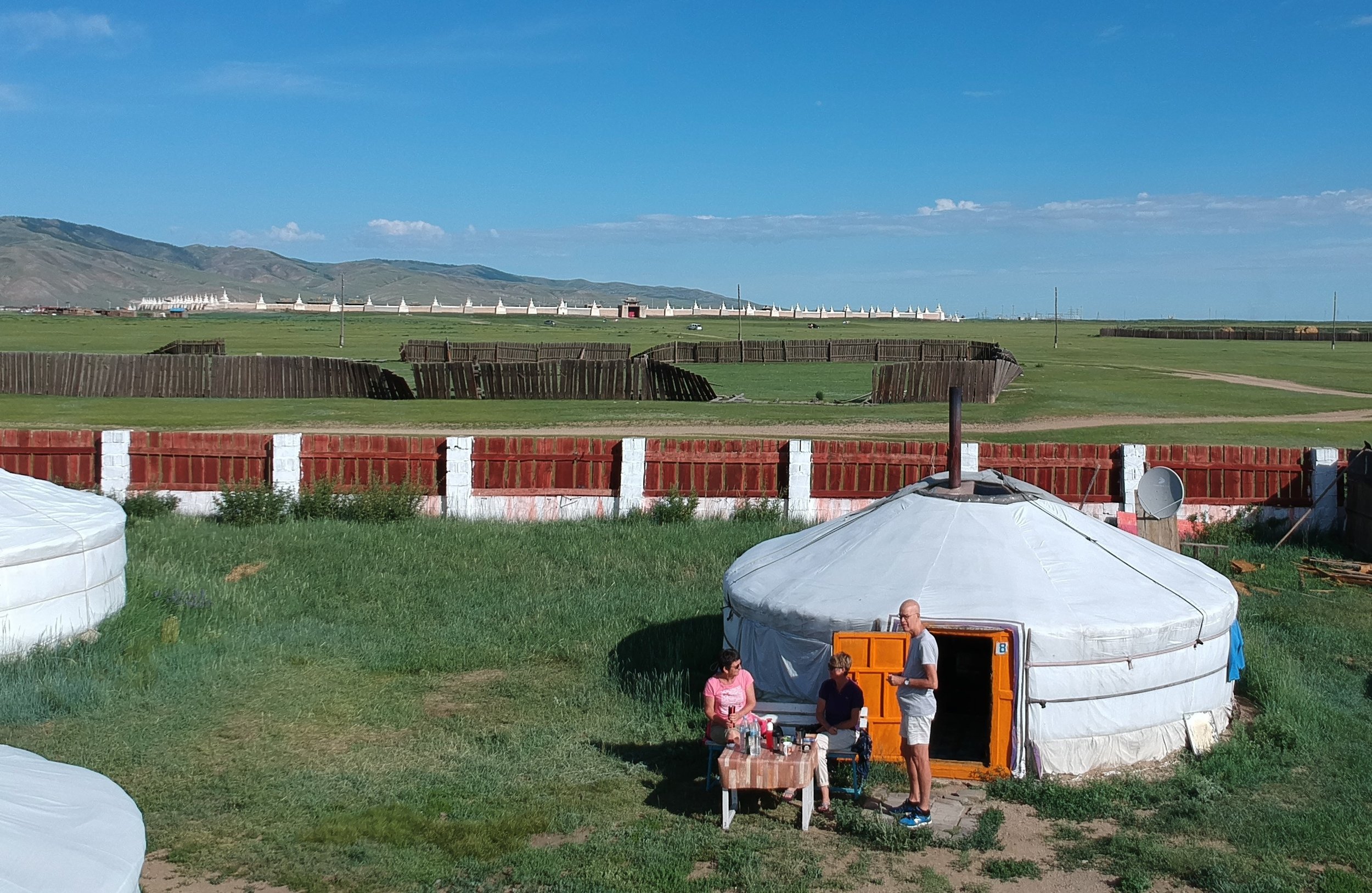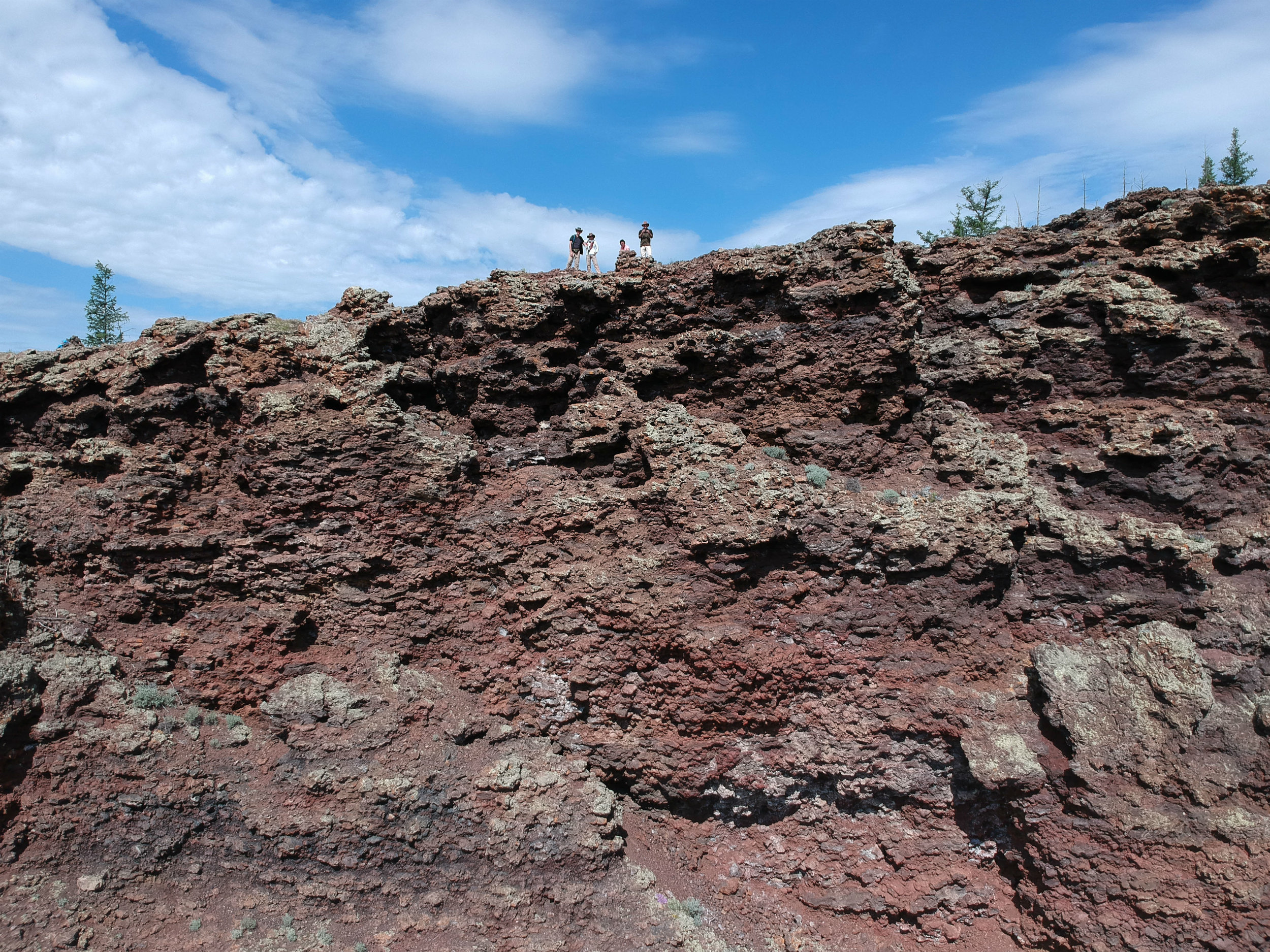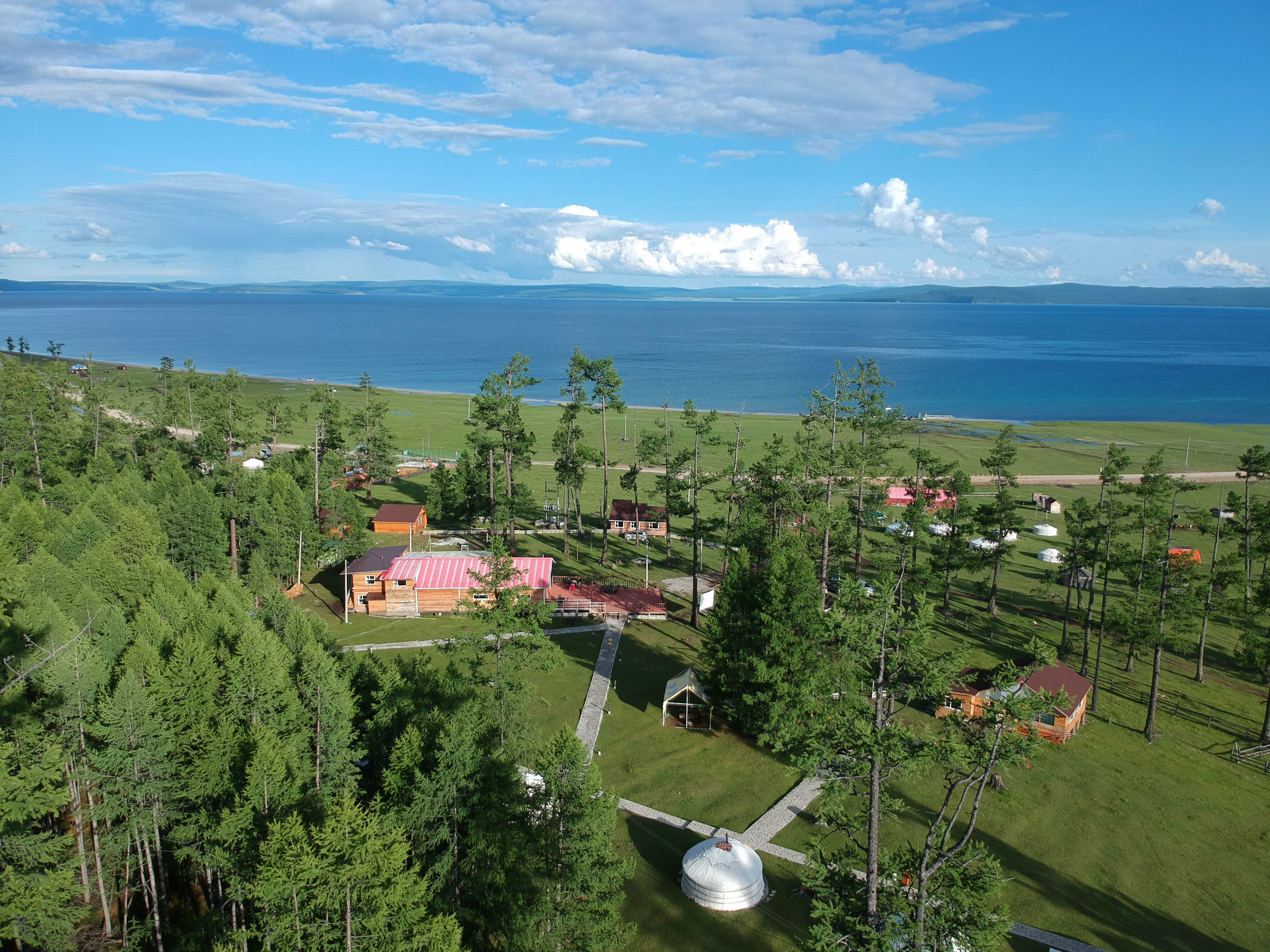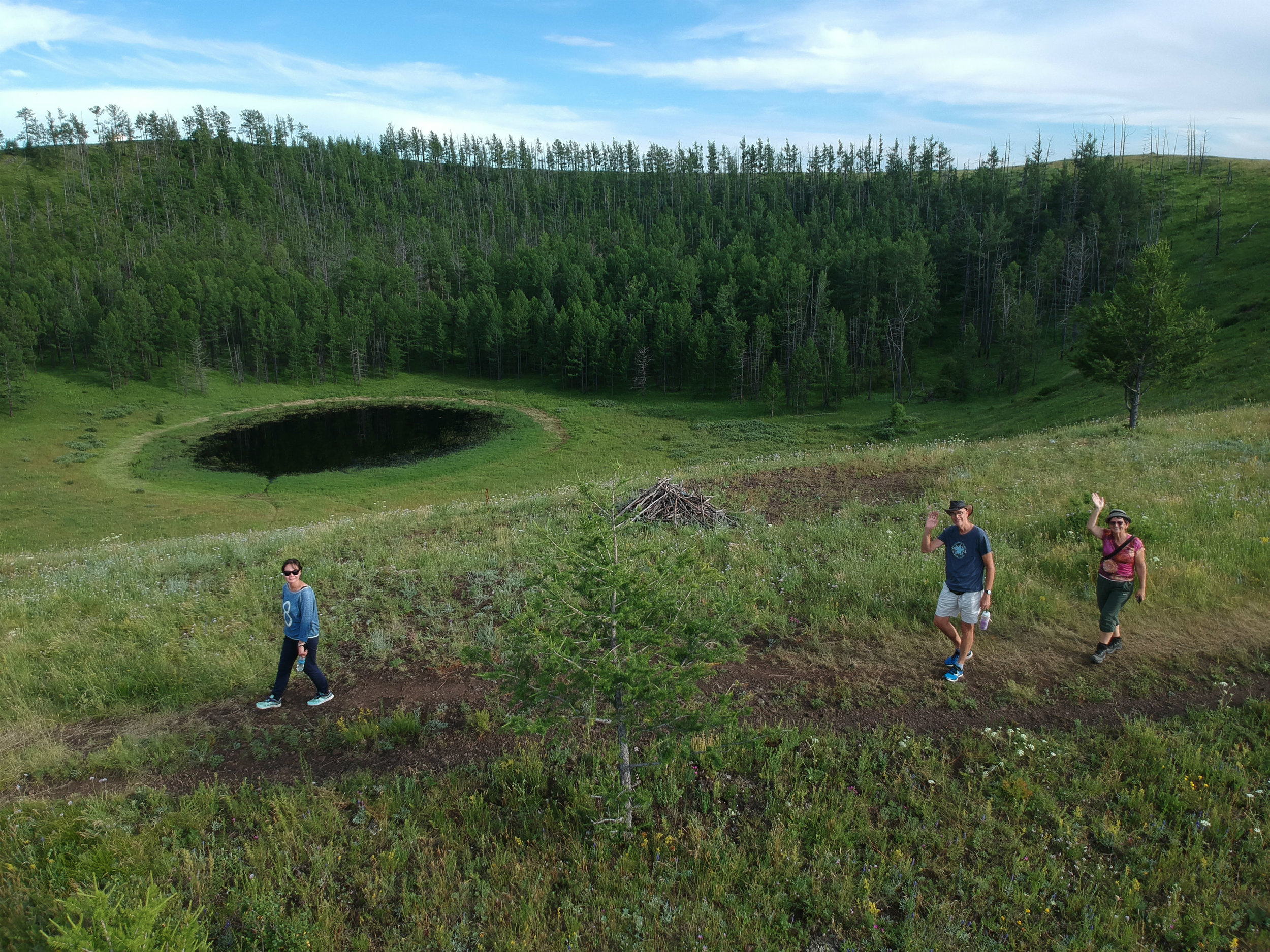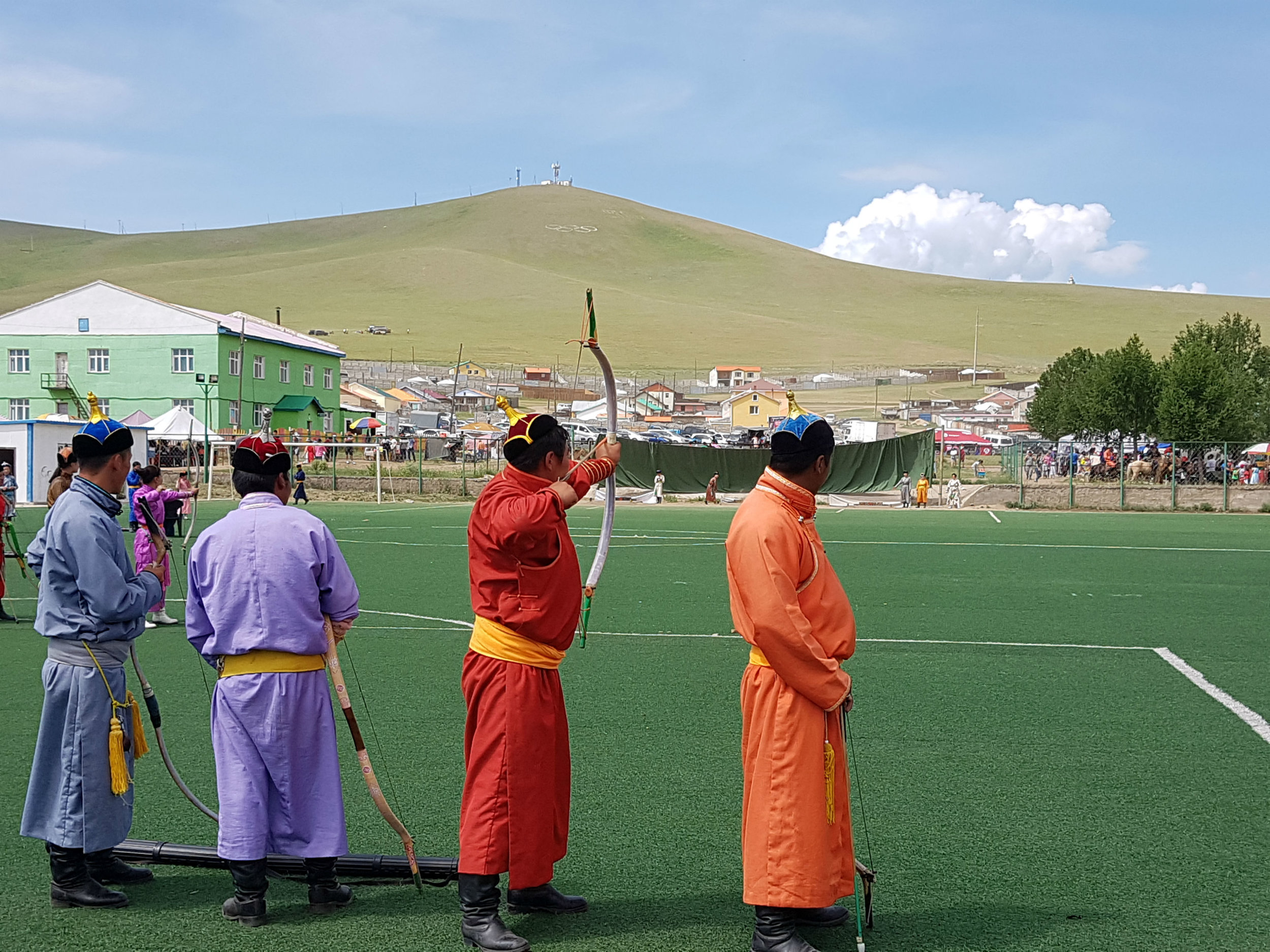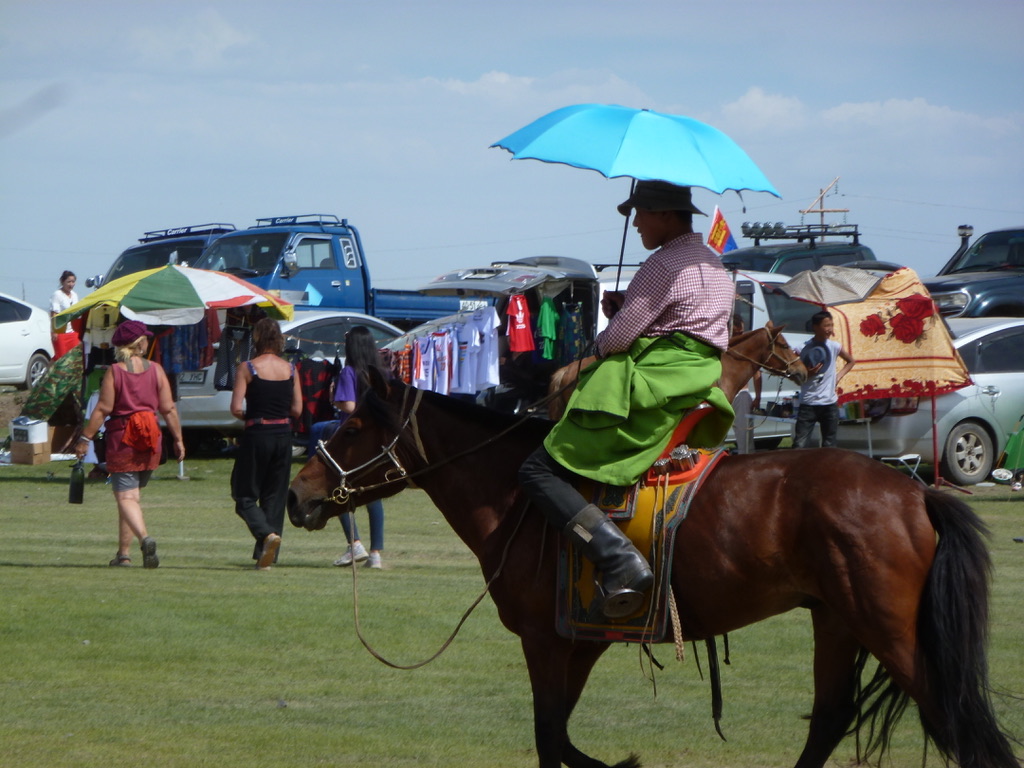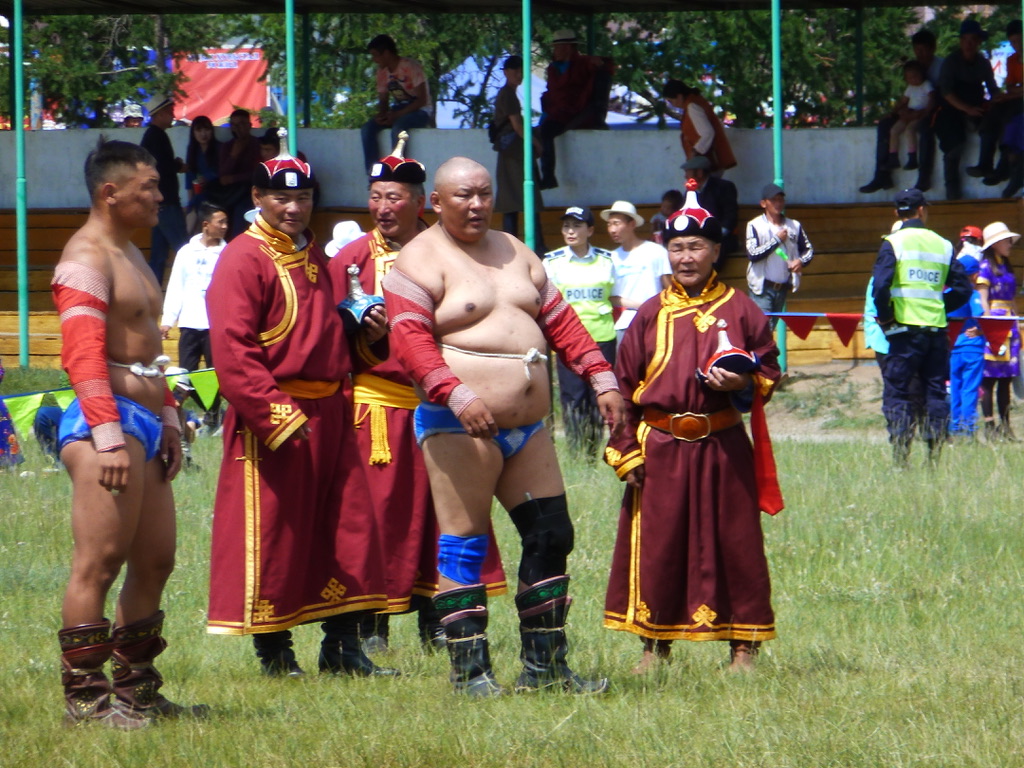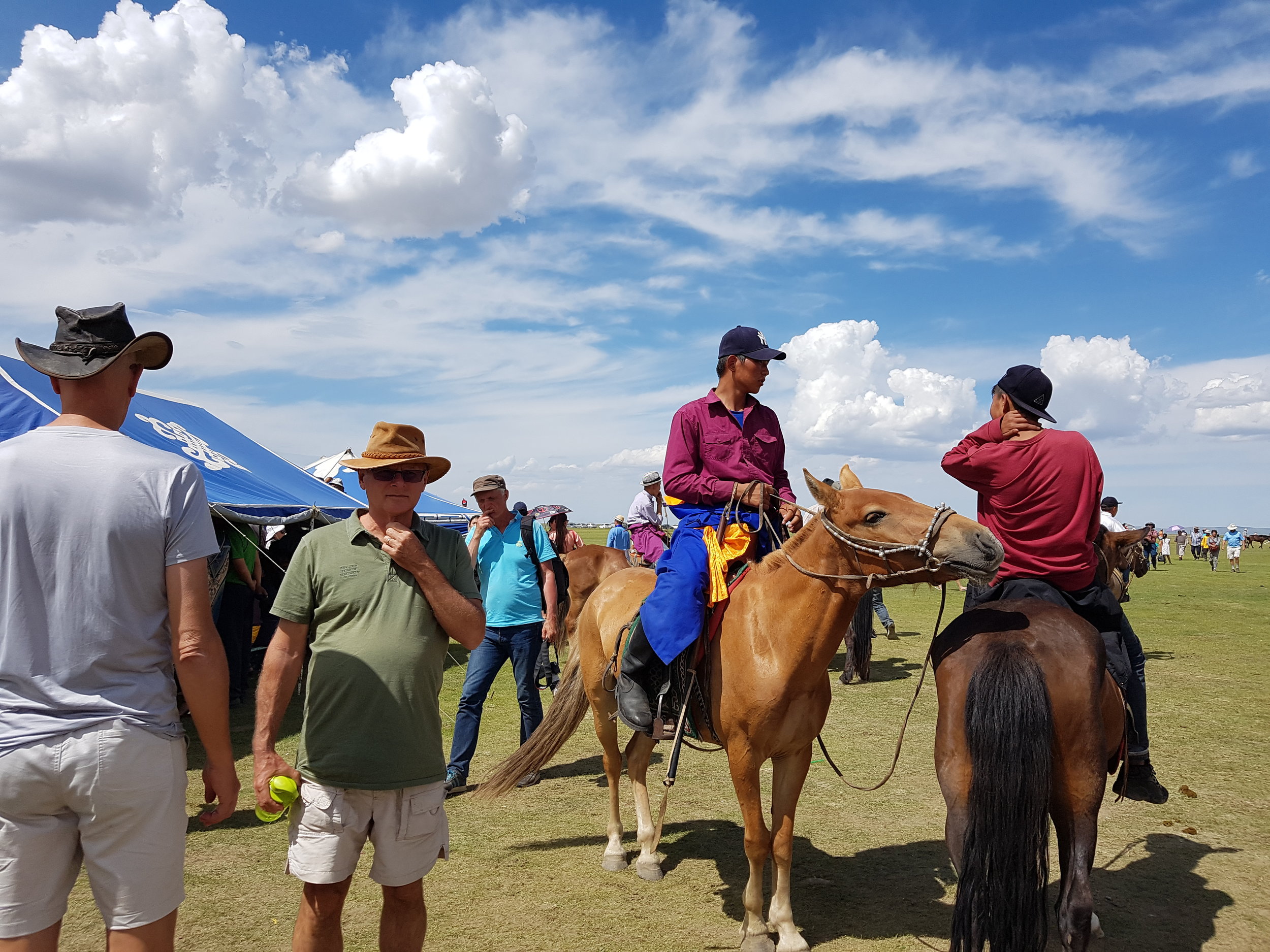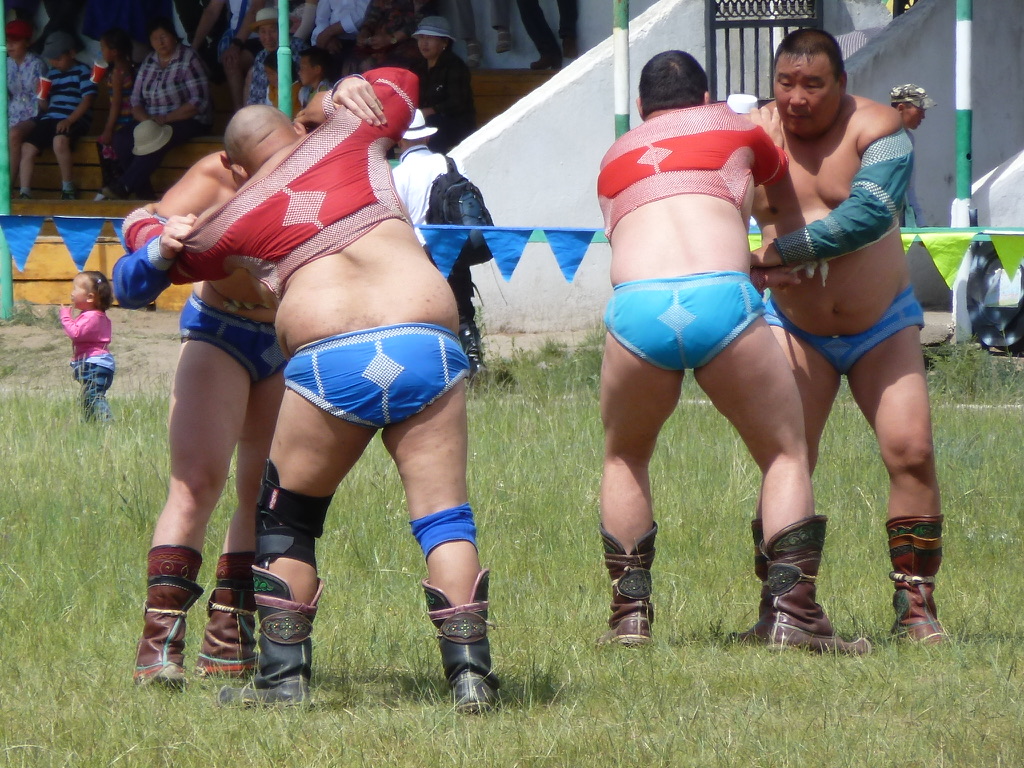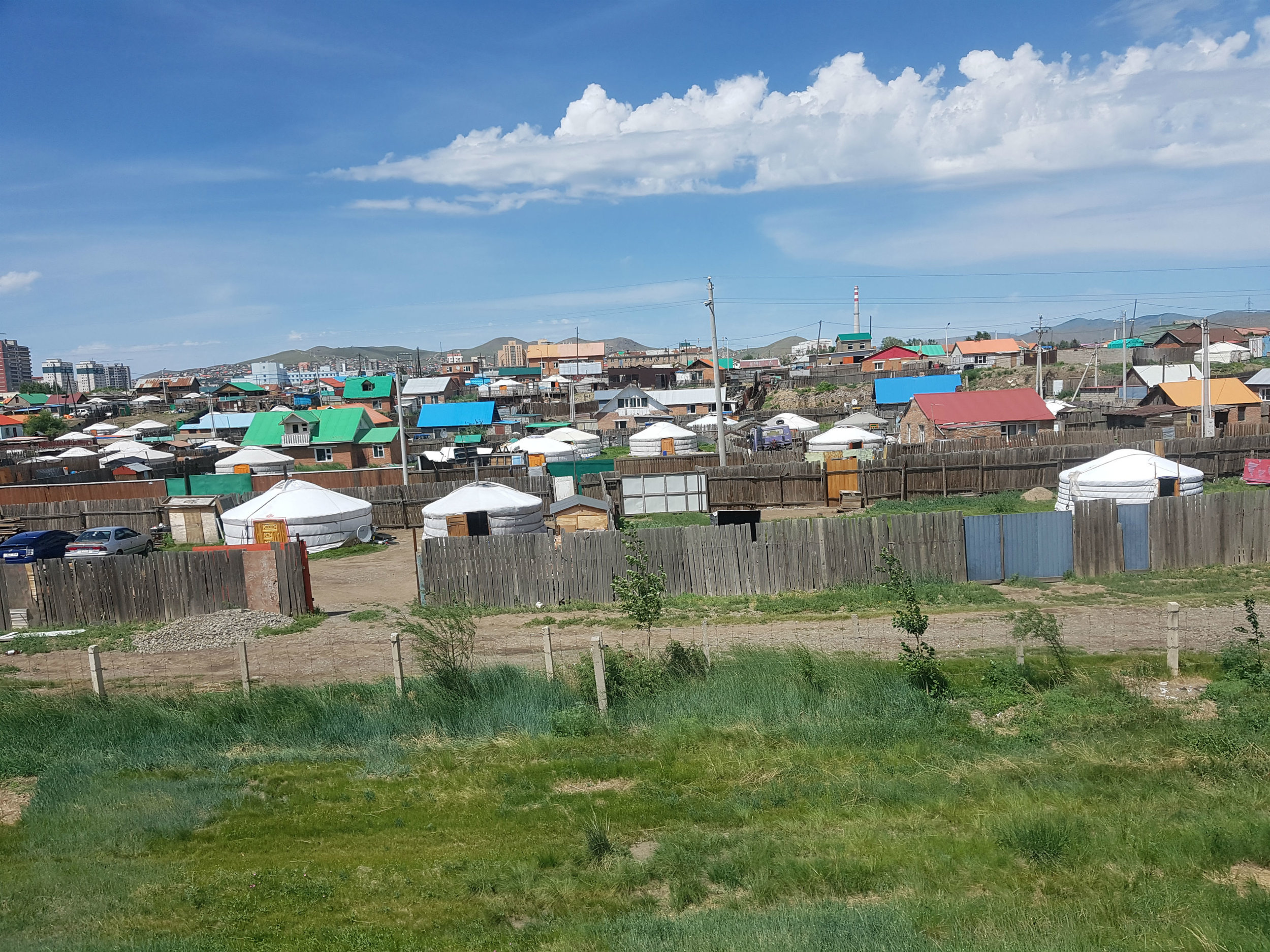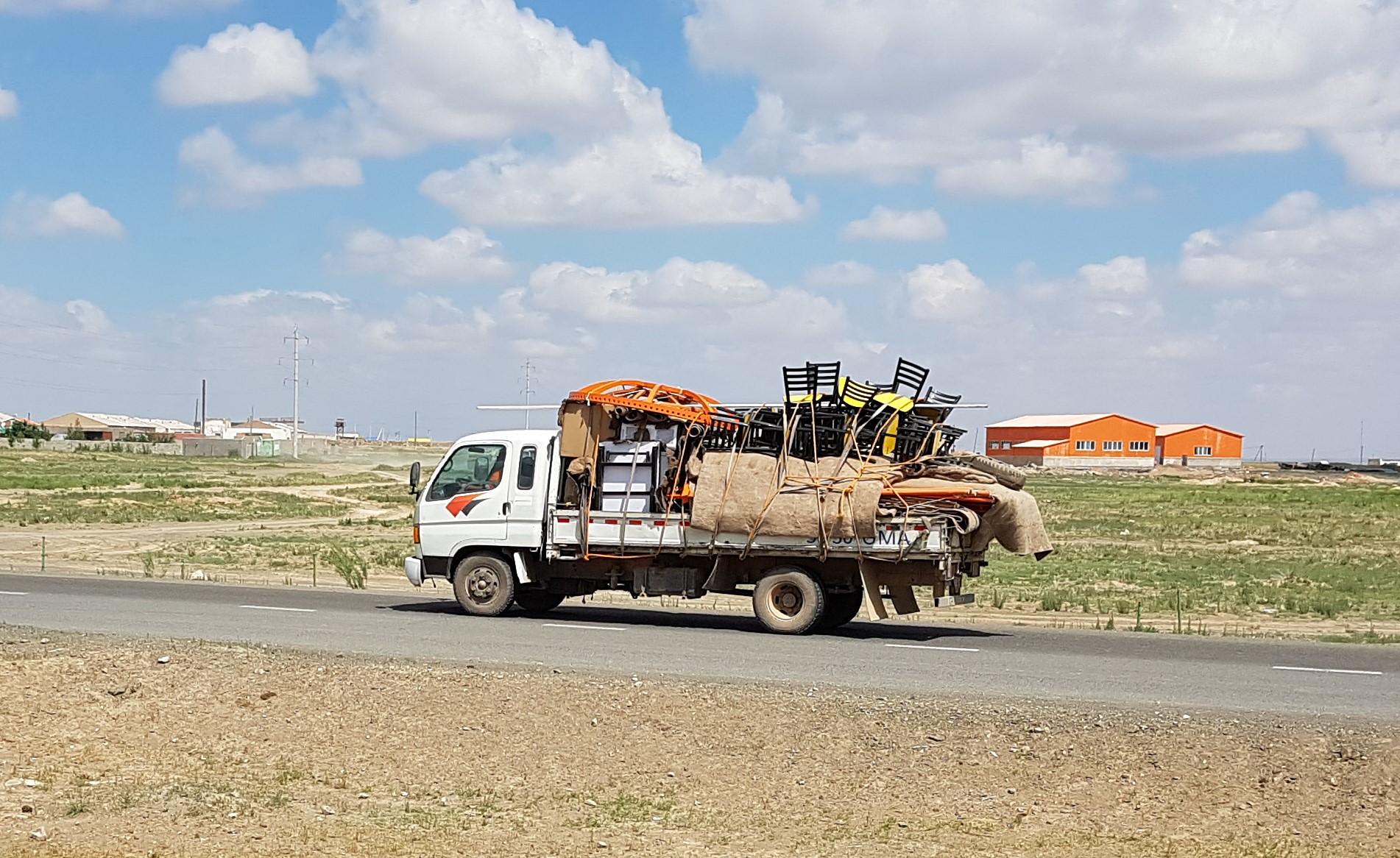Francien and I have developed into 'new experience' collectors. So what made our venture to Mongolia matter more to us? Our 4000 km journey through this most sparsely populated nation in the world started at the Erlian border crossing. We had boarded the Trans-Mongolia train in Beijing 12 hours earlier. Here the gauge of the railway tracks changes, switching to the Russian built tracks, which are 85 mm wider than the rest of the world. Therefore, the wheels (bogeys) under the train carriages were changed. Hydraulic jacks lifted our carriage one metre up in the air and put it down again on a new set of different gauge bogeys. Each of the 21 carriages was separated, lifted one by one, shunting carriages back and forth, all with loud thumbs and jolting. All the passengers remained locked inside their carriage. This meant the air conditioning was switched off and the toilets all locked shut for the three-hour duration of the entire process. Welcome to Mongolia.
Nothing could be in more contrast with the glitzy Beijing skyline than the open and remote expanses of the countryside we saw through the windows of our train heading north. Camels, horses and sheep roaming the endless plains. We passed a few poor looking villages with scattered rubbish belts, demolished houses, small brick houses with no paint and a few gers. We arrived in Ulaanbataar, the coldest capital city in the world (-40 C in winter), but fortunately for us now a balmy 23 C.
Our friends Berry and Pamela joined us on this trip and with our guide Sheerze and driver Tuggy we explored this country, the size of Western Europe, in a 15-year-old Russian UAZ Buhanka. It had a smelly exhaust, no seatbelts, no air conditioner, a hand-choke to start in the cold mornings, hard suspension, but a heavy and sturdy four-wheel drive. During our trip, Tuggy tinkered a few times with the engine because it didn’t start: thumbs-up, each time he fixed the problem. He grew up as a nomadic herdsman and it turned out that he knew the non-mapped vast steppe like the back of his hand.
From Ulaanbataar we first headed in southerly direction, to the Gobi Desert. Off road on endless dirt tracks, crossing the desolated dry landscape. We reached driving speeds up to 90 km/hr and when we hit an unexpected bump, it felt as if we all were airborne: at times I was hanging on for dear life. On a 1600-meter altitude semi-arid plateau we crossed flat plains, rocky outcrops, cragged mountain ranges and dry riverbeds. The windows of the car we kept rolled down, enjoying the rushing of dry air.
Close to the Chinese border, we then turned north to central Mongolia. On cross-country tracks we drove the lonely paths of the remote steppe. Day in, day out we drove and drove through barren landscapes. Occasionally we stopped at a gas station in a nowhere town. These settlements were built by the government to support the nomadic families living within a range of 150 km. There was a medical clinic, boarding school, government office, police station, supply store, community shower facilities and dilapidated houses. Dusty and barren, a jumble of brick and concrete buildings. These towns felt like far flung outpost of civilization. The people were grayish dressed with no smiles on their faces. Loudspeakers on the square played jolly music, a practice from the Soviet era. The presence of foreigners in some of these places was clearly something special for the local children. In Mandel Ovoo the few boys ask us to play football with them on the gravel square in front of a супермаркет. These tiny shops had packaged foods and sometimes we picked up a few rare fresh vegetables. We carried the food and drinking water in the back of our van, a mixture of noodles, pasta, rice, eggs, cookies, chocolates and wine.
We are driving through the endless steppe
Further north we crossed the endless steppe, the terrain became increasingly mountainous and driving more challenging. Bone crushing off-roading, over hilly terrain, rocks, deep swampy mud, rivers and collapsed bridges. An afternoon storm hit us, and we battled some flash floods: storm water rushing from the mountains, turning dry riverbeds into mud flows, dangerous to cross. We made five hair-raising river crossings. Sedan cars were being swept away in the rising rivers, I had never seen anything like this. It was a long bumpy drive to the Khusluv Lake bordering Russia. This was the most remote place we have been.
Every night we stayed in a ger owned by a nomadic herdsman family. A ger is a traditional round shaped tent, used by the nomads since 3000 years. It consists of felt covers, wooden columns, and a round window at the top. It has thin wooden poles holding the roof, 4 – 6 beds and a stove in the middle. The owner of one ger in the Gobi Desert welcomed us with milk- (from their goats) tea. We all squatted inside his ger around a table without legs. He had us sniff his snuff bottle, a feudal tradition welcoming any guests.
‘Our children all live and work in the big city,’ he explained to us, ‘but they come and help me when I move our ger to another pasture when the season changes. I have 50 camels and that is all my wife and I need to live.’
At the Terkh Lake the mother of another family let us taste yak cheese and self-made vodka. The camps had no running water nor any sanitation to speak off. Only outside pit latrines were provided. These families live off the land, moving as the seasons change. In the northern parts of Mongolia close to the Russian border the nights were cold. Then we heated our ger with wood, the white smoke curling out of the metal chimney. We sat next to the gentle crackling stove to keep warm. Here our existence was stripped down to our backpacks, our smartphones with low running batteries and the car. No internet, no phone connection, the nearest real city was two-day driving. However, some gers had solar panels, providing enough energy to load our batteries and give the owner power for a small TV set: progress in the making. One morning we woke up by the sounds of the yaks grazing around our ger. A herder drove them together to milk them.
One highlight in the Gobi Desert are the Khongoryn Els sand dunes. We were on 2000 meters elevation above sea level. The sun was burning, sand dunes along the horizon. The sands have wave like curves, but on the top end with a sharp edge. It was on these edges we wanted to stand on and decided to climb up the 250-meter-high ‘singing’ dune (because you can hear the movement of the fine sand when the wind blows). The sensation of climbing these dunes was disorienting. We climbed up and it felt as if we made one step up and three down in the shifting sand. There was no wind, so I heard no singing, but instead my own heartbeat. It was a difficult 50-minutes climb, but worth it. The view from the top was magical: a sea of calm sand dunes as far as the eye could see. The real magic of the place was the volume of tourists; only a handful of foremost young backpackers made it to the top. It was here in the desert that we saw the free roaming Bactrian (two humps) camels, with nomadic herdsmen on their small horses never far away.
The Flaming cliffs was another remarkable place. Still in the Goby desert, the landscape had red tinted soft rocks, shrubs, sand dunes and endless emptiness. It was here that the world’s first dinosaurs’ skeletons from the Cretaceous period were found in 1922.
The rutted roads were hard, the soil dry and only supported growth of sturdy grass and shrubs. The wideness of steppe was anything I had seen before. I could see the curve of the earth like one sees when on the open ocean. Having so much space to myself was a humbling experience. I lost my sense of direction, because with no landscape features to be seen, for me it was impossible to know in what direction we needed to go to.
‘Tuggy, how do you know we are driving in the right direction and how do you know you have to turn, even though everything looks the same, no orientation points?’
He spoke no English, but our guide translated:
‘I cannot answer you, I simply know.’ his stunning answer was.
Everywhere cattle roamed freely. This is a land of no boundaries of time, space and thoughts. No fences, no roads, no power-lines, where wind swept unchecked across the vast expanses of the plains. Sometimes a ger in the middle of nowhere. The sense of space was immense. We saw marker cairns called ovoos, covered with colorful banners to please the gods. A reminder that the majority of people is Buddhist. An occasional carcass of a camel or horse, but no vultures or any other scavenger. In fact, we saw no wildlife apart from a snake, beetles, meerkats, cranes, fox and grasshoppers. Driving north into middle Mongolia the landscape became greener, and trees started to appear. The olive-green grassland stretched into the distance. We were in the middle of the country and headed north to the Russian taiga. Have I said these steppe, deserts and mountains are endless and lonely? I was struck how much the landscape kept changing during the entire journey. But also the weather changed as quick as the landscape: one hour sunshine, next thunderstorms turned dusty roads into muddy impassable tracks in a matter of hours.
It was the week of the annual Naadam festival. As we passed by several towns, we had the opportunity to watch some horse racing, wrestling and archery. The people were colorfully dressed, many on horseback. While watching a wrestling match, an old man sitting next to me offered his snuff bottle to me; his way off welcoming me. Many locals enjoyed their family holidays, camping and picnicking in the fields.
Mostly we met the nomads when we stopped at the small settlements and towns, were they bought supplies. The herders wore traditional clothing and were sturdy build. They had red cheeks, reddish skin tone and prominent weather-beaten cheekbones. When they talked, they showed no emotions and had stern facial expressions. They are superstitious people and we saw them often throwing their shagai: sheep ankle bones which tell them their fortunes. And Sheerze would never commit to any distance we still needed to travel or time it would take to get to our next destination:
‘I believe the gods will determine exactly what will happen.’ she explained to us when we insisted to get some more accurate information’s from her.
We learned that the Mongolians feel more related to the Russians and make jokes about the Chinese. They do not like the inner Mongolians, because the Chinese give them money to remain in China and regard them as traitors. As in so many other countries, the sentiment between different people is determined by their common experiences in the not so distant past.
The stench of the pit latrines we were supposed to use was nauseating. It was too hard not to write this. Half the world population has no adequate sanitation and that fact got more meaning to me. We learned that all the settlements we passed had no sewage. So the best option for us: going to the toilet squatting in the bushes. My first shower after four days traveling was a coal fired hot water tank with water from a well, giving it a muddy taste. In another camp we showered with sulfur containing spring water, a strange but healthy experience.
In our camp on the shores of Lake Terkhin Tsagaan, we watched the owner family slaughter a sheep. As the sheep was alive, four men held it down on its back. One of them made a 20-centimeter incision in the rib cage and pushed his hand inside the body, up to the heart. He pressed the heart muscle, instantly killing the animal.
‘Why do you do this?’ I asked somewhat surprised.
‘This is the Buddhist method of killing sheep. The least painful’, our guide interpreted him.
The next day, the family prepared all the parts of the animal in big pots above the fire-pit in front of their hut. Looking at that stew on the fire killed my appetite! I cringed at the idea of having to eat boiled stomach, boiled intestine, boiled heart, eyes, tongue…
Showering every four days and eating the same foods became somewhat natural. But after 15 days we started to appreciate the luxuries in live such as a clean toilet and hot shower. Please don’t take this as criticism, it simply is an observation.
This country is a real outdoor country. We stood on the shores of this lake and gazed at the water glinting metalic, reflecting the overcast sky. There we climbed the nearby extinct volcano Khorgo Uul, flanked with pine-clad black lava fields. From the top we had a view across the lake which by now had turned deep blue in color. We also hiked on the rim of the Uran Tongoo volcano, green with water inside the cone. Pamela, Berry, Francien and myself also walked a couple of hours on the slopes of Tsagaan Hysaat amid pine scented forest, with views across the deep blue Khuvsgul Lake. We bathed in the Tsenkhor Hotsprings and did horse riding on the shores of the Khuvsgul Lake.
Throat-singing performance. Note the traditional Morin Khuur they are playing
I can now hear you asking: ‘Is there anything else in Mongolia besides landscapes and cattle?’ Yes, we all know about the Genghis Khan and his Mongolian Empire. But only very little from those days and more recent history is left. We visited the Ongi Monastry, destroyed during the communist purge in 1939. Built in 1750, only mud walls left except for one renovated temple. Pure destruction of history besides murders of thousands of monks. I tried to understand the reason for destroying this ancient monument down to the very foundations, leaving absolutely nothing intact: cultural barbarism! In Kharkhorin city, another gritty Soviet built town where cattle roamed through gravel streets, we visited the partly restored monastery. This was the ancient capital of the Mongolian Empire and the monastery was an interesting mix between Tibetan and local Buddhism. But here again we learned that from the ancient capital city as well as its monastery nothing has been left, completely raised by invaders, last but not least the Soviets.
Much to our surprise in our camp in Kharkhorin one evening, we watched three men playing on their Morin Khuur and performing throat-singing. This is a singing technique whereby they produce a fundamental pitch and—simultaneously—one or more pitches over that. I was impressed by the unique sound effects these guys made and their dedication and passion for this art. Will the younger generation keep this ancient tradition alive?
The last day only 300 km paved roads remained back to the capital. We saw trucks loaded with raw wool driving to the factories in city. We saw a nomad family moving their ger on a truck. At midday we drove into Ulaanbataar through a grey Soviet built industrial area with dirty old cooling towers, industrial yards and warehouses, trash, flooded potholes. Sombre prefabricated apartment blocks and more communist style architecture. We smelled the polluted air after 15 days breathing pure fresh air. This is NOT the most beautiful city in the world. Seeing the gers on the outskirts (from people moving to the city for a better live) and the skyline was where tradition met modernity. Most of the younger generation here wore modern clothing. Was it also where tradition met progress?
Sometimes travel surprises you in the most wonderful way: it felt this desolate country was removed from the rest of the world. I remember Sheerze explain to us: ‘When you live in a city, you need a job to earn money. When you live in the steppe, you can live of the land.’ This is a country where simplicity rules.
We were privileged to experience one of the last places on the planet where nomadic life is still a living tradition. I ended this trip wondering how long this still will last.

